Analysis, Design And Simulation Of Smart Grid
VerifiedAdded on 2023/03/31
|41
|7701
|400
AI Summary
This study explores the analysis, simulation, and design of smart grids to deliver maximum efficiency. It discusses the challenges faced and proposes strategies for reliable and resilient smart grids. The research aims to identify the most efficient analytical, simulation, and design methodologies for smart grids.
Contribute Materials
Your contribution can guide someone’s learning journey. Share your
documents today.
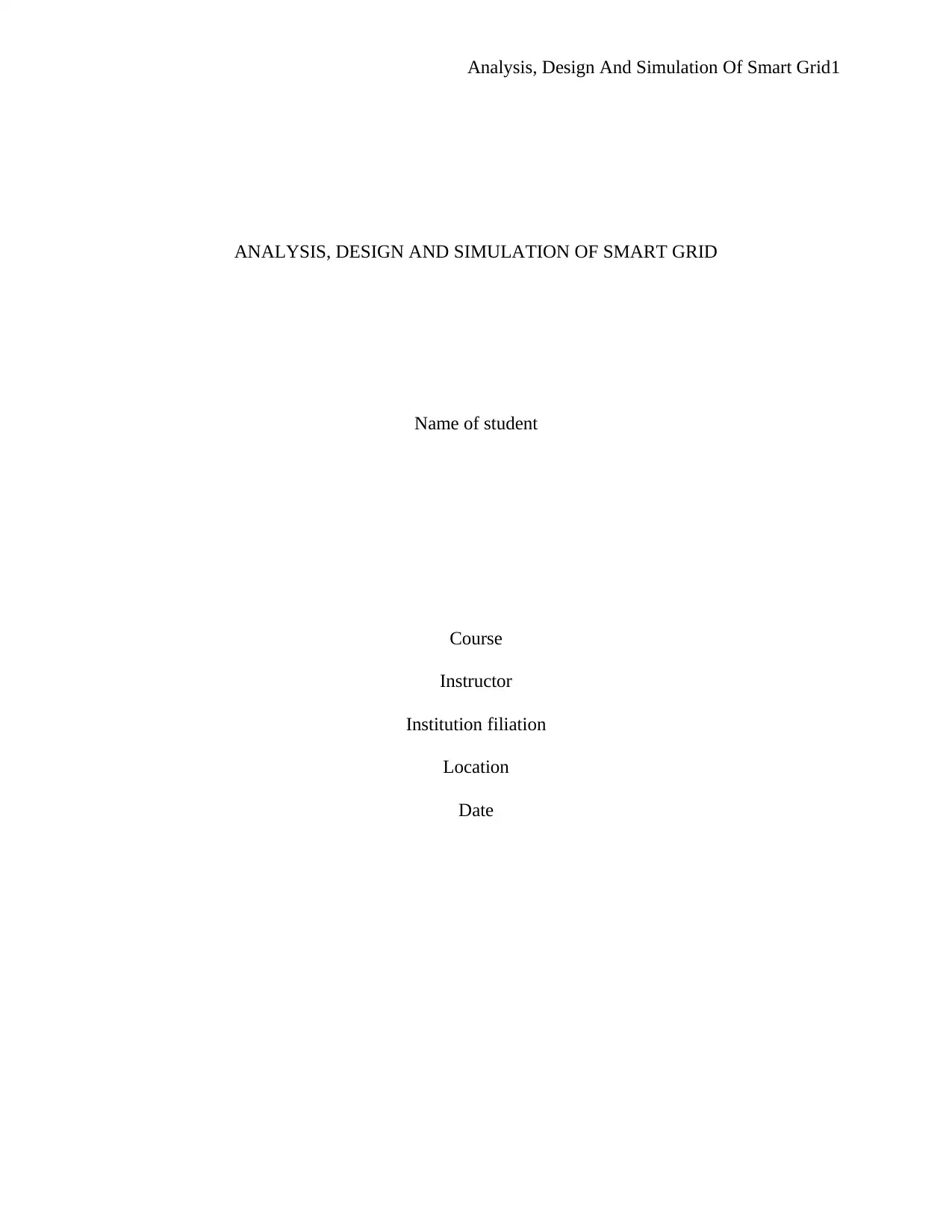
Analysis, Design And Simulation Of Smart Grid1
ANALYSIS, DESIGN AND SIMULATION OF SMART GRID
Name of student
Course
Instructor
Institution filiation
Location
Date
ANALYSIS, DESIGN AND SIMULATION OF SMART GRID
Name of student
Course
Instructor
Institution filiation
Location
Date
Secure Best Marks with AI Grader
Need help grading? Try our AI Grader for instant feedback on your assignments.
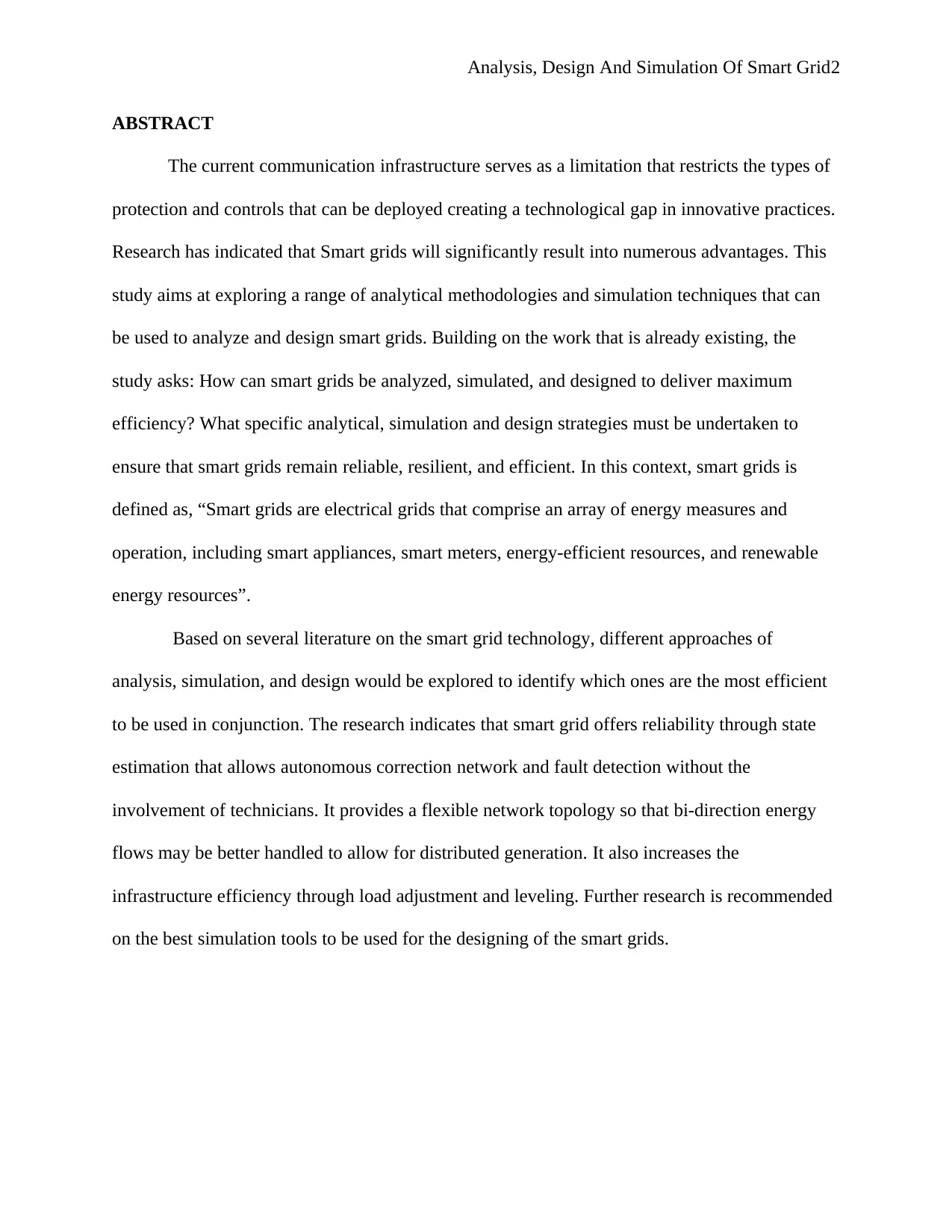
Analysis, Design And Simulation Of Smart Grid2
ABSTRACT
The current communication infrastructure serves as a limitation that restricts the types of
protection and controls that can be deployed creating a technological gap in innovative practices.
Research has indicated that Smart grids will significantly result into numerous advantages. This
study aims at exploring a range of analytical methodologies and simulation techniques that can
be used to analyze and design smart grids. Building on the work that is already existing, the
study asks: How can smart grids be analyzed, simulated, and designed to deliver maximum
efficiency? What specific analytical, simulation and design strategies must be undertaken to
ensure that smart grids remain reliable, resilient, and efficient. In this context, smart grids is
defined as, “Smart grids are electrical grids that comprise an array of energy measures and
operation, including smart appliances, smart meters, energy-efficient resources, and renewable
energy resources”.
Based on several literature on the smart grid technology, different approaches of
analysis, simulation, and design would be explored to identify which ones are the most efficient
to be used in conjunction. The research indicates that smart grid offers reliability through state
estimation that allows autonomous correction network and fault detection without the
involvement of technicians. It provides a flexible network topology so that bi-direction energy
flows may be better handled to allow for distributed generation. It also increases the
infrastructure efficiency through load adjustment and leveling. Further research is recommended
on the best simulation tools to be used for the designing of the smart grids.
ABSTRACT
The current communication infrastructure serves as a limitation that restricts the types of
protection and controls that can be deployed creating a technological gap in innovative practices.
Research has indicated that Smart grids will significantly result into numerous advantages. This
study aims at exploring a range of analytical methodologies and simulation techniques that can
be used to analyze and design smart grids. Building on the work that is already existing, the
study asks: How can smart grids be analyzed, simulated, and designed to deliver maximum
efficiency? What specific analytical, simulation and design strategies must be undertaken to
ensure that smart grids remain reliable, resilient, and efficient. In this context, smart grids is
defined as, “Smart grids are electrical grids that comprise an array of energy measures and
operation, including smart appliances, smart meters, energy-efficient resources, and renewable
energy resources”.
Based on several literature on the smart grid technology, different approaches of
analysis, simulation, and design would be explored to identify which ones are the most efficient
to be used in conjunction. The research indicates that smart grid offers reliability through state
estimation that allows autonomous correction network and fault detection without the
involvement of technicians. It provides a flexible network topology so that bi-direction energy
flows may be better handled to allow for distributed generation. It also increases the
infrastructure efficiency through load adjustment and leveling. Further research is recommended
on the best simulation tools to be used for the designing of the smart grids.

Analysis, Design And Simulation Of Smart Grid3
ACKNOWLEDGMENTS
I would like to begin by saying a word of thank you to my thesis advisor. His office was always
open whenever I had a problem with my thesis work. Consistently, he encouraged me to give my
best in the paper.
Also, I sincerely thanks the librarian who gave allowed me to do my research in the laboratory
and research facilities with less restriction. Finally, I must appreciate my parents for their
unending support and ceaseless reassurance through the process of researching and writing this
thesis. Lastly, I dedicate all this effort unto God for the His unending guidance, love and care as I
undertake my studies and particularly in this thesis work,
Author
ACKNOWLEDGMENTS
I would like to begin by saying a word of thank you to my thesis advisor. His office was always
open whenever I had a problem with my thesis work. Consistently, he encouraged me to give my
best in the paper.
Also, I sincerely thanks the librarian who gave allowed me to do my research in the laboratory
and research facilities with less restriction. Finally, I must appreciate my parents for their
unending support and ceaseless reassurance through the process of researching and writing this
thesis. Lastly, I dedicate all this effort unto God for the His unending guidance, love and care as I
undertake my studies and particularly in this thesis work,
Author
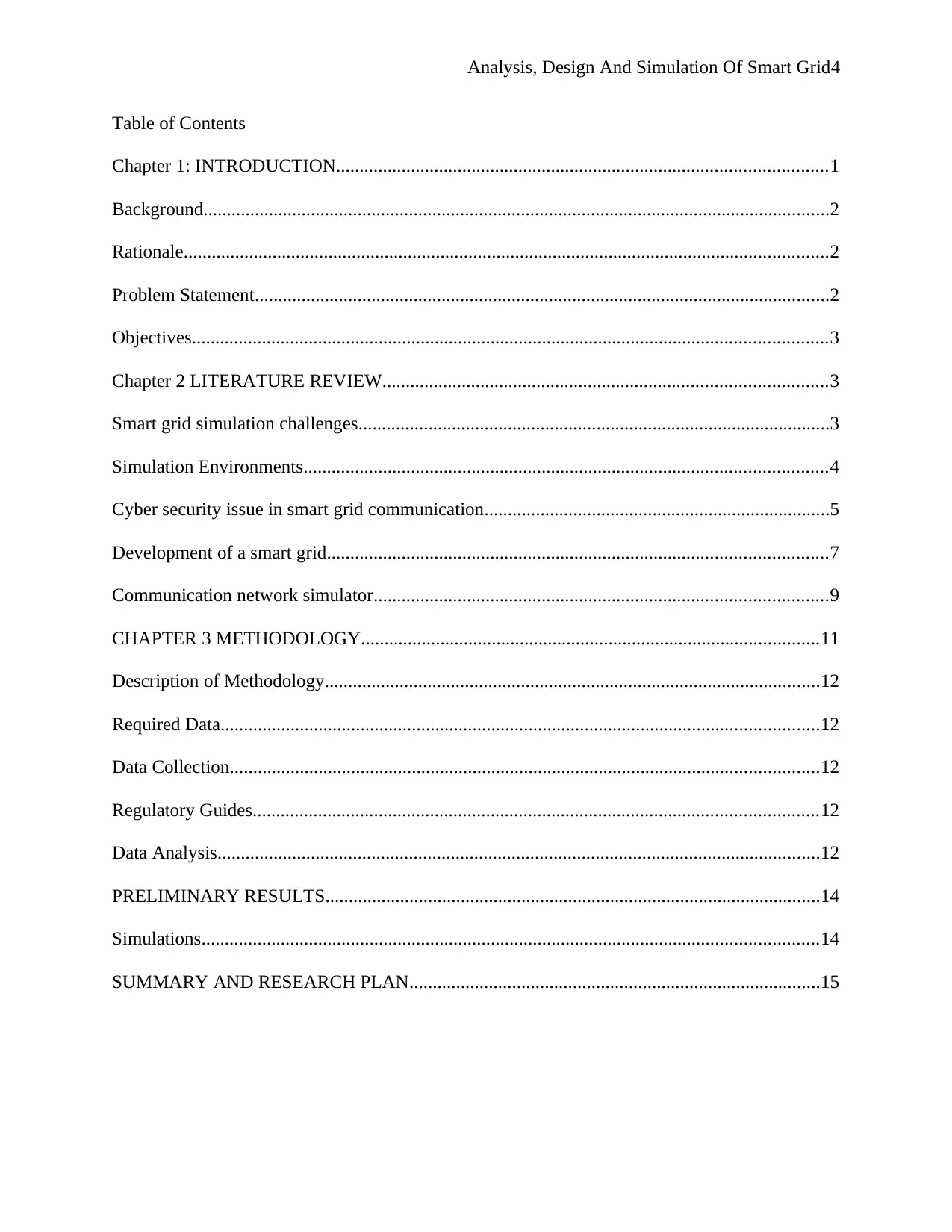
Analysis, Design And Simulation Of Smart Grid4
Table of Contents
Chapter 1: INTRODUCTION.........................................................................................................1
Background......................................................................................................................................2
Rationale..........................................................................................................................................2
Problem Statement...........................................................................................................................2
Objectives........................................................................................................................................3
Chapter 2 LITERATURE REVIEW...............................................................................................3
Smart grid simulation challenges.....................................................................................................3
Simulation Environments................................................................................................................4
Cyber security issue in smart grid communication..........................................................................5
Development of a smart grid...........................................................................................................7
Communication network simulator.................................................................................................9
CHAPTER 3 METHODOLOGY..................................................................................................11
Description of Methodology..........................................................................................................12
Required Data................................................................................................................................12
Data Collection..............................................................................................................................12
Regulatory Guides.........................................................................................................................12
Data Analysis.................................................................................................................................12
PRELIMINARY RESULTS..........................................................................................................14
Simulations....................................................................................................................................14
SUMMARY AND RESEARCH PLAN........................................................................................15
Table of Contents
Chapter 1: INTRODUCTION.........................................................................................................1
Background......................................................................................................................................2
Rationale..........................................................................................................................................2
Problem Statement...........................................................................................................................2
Objectives........................................................................................................................................3
Chapter 2 LITERATURE REVIEW...............................................................................................3
Smart grid simulation challenges.....................................................................................................3
Simulation Environments................................................................................................................4
Cyber security issue in smart grid communication..........................................................................5
Development of a smart grid...........................................................................................................7
Communication network simulator.................................................................................................9
CHAPTER 3 METHODOLOGY..................................................................................................11
Description of Methodology..........................................................................................................12
Required Data................................................................................................................................12
Data Collection..............................................................................................................................12
Regulatory Guides.........................................................................................................................12
Data Analysis.................................................................................................................................12
PRELIMINARY RESULTS..........................................................................................................14
Simulations....................................................................................................................................14
SUMMARY AND RESEARCH PLAN........................................................................................15
Secure Best Marks with AI Grader
Need help grading? Try our AI Grader for instant feedback on your assignments.

Analysis, Design And Simulation Of Smart Grid5
Table of figures
Figure 1 System operation over time (Source: Albasrawi et al., 2014) 7
Figure 3: Conceptual Models Of The Smart Grid 11
Figure 4: Picturesque View of the Smart Grid 11
Figure 5: Interface of DSDYN and DSOUT 14
Figure 6: OPNET Simulation 15
Figure 7: Event Handling 16
Figure 8 Steps for Methodology (Source: Self-created) 17
Figure 9: Power System and the Communication Network Simulators 19
Figure 10: Simulation Stands for Power Grid and Communication Network Respectively 20
Figure 11: Simulation Results 20
Figure 12: Flow of Co-Simulation and Event Handling 21
Tables
Table 1: Work Plan (Source: Self-created) 22
Table 2: Gantt chart (Source: Self-created) 23
Table of figures
Figure 1 System operation over time (Source: Albasrawi et al., 2014) 7
Figure 3: Conceptual Models Of The Smart Grid 11
Figure 4: Picturesque View of the Smart Grid 11
Figure 5: Interface of DSDYN and DSOUT 14
Figure 6: OPNET Simulation 15
Figure 7: Event Handling 16
Figure 8 Steps for Methodology (Source: Self-created) 17
Figure 9: Power System and the Communication Network Simulators 19
Figure 10: Simulation Stands for Power Grid and Communication Network Respectively 20
Figure 11: Simulation Results 20
Figure 12: Flow of Co-Simulation and Event Handling 21
Tables
Table 1: Work Plan (Source: Self-created) 22
Table 2: Gantt chart (Source: Self-created) 23
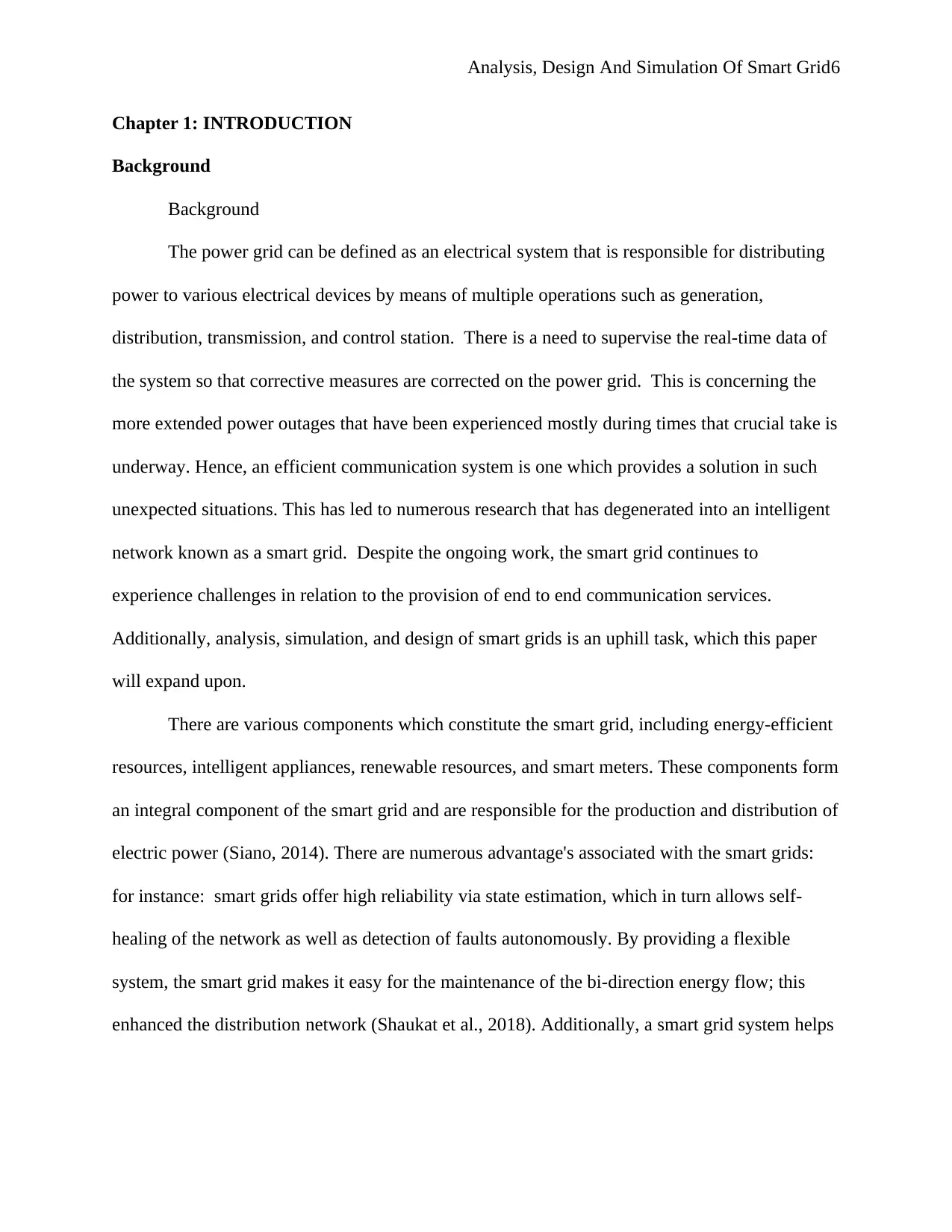
Analysis, Design And Simulation Of Smart Grid6
Chapter 1: INTRODUCTION
Background
Background
The power grid can be defined as an electrical system that is responsible for distributing
power to various electrical devices by means of multiple operations such as generation,
distribution, transmission, and control station. There is a need to supervise the real-time data of
the system so that corrective measures are corrected on the power grid. This is concerning the
more extended power outages that have been experienced mostly during times that crucial take is
underway. Hence, an efficient communication system is one which provides a solution in such
unexpected situations. This has led to numerous research that has degenerated into an intelligent
network known as a smart grid. Despite the ongoing work, the smart grid continues to
experience challenges in relation to the provision of end to end communication services.
Additionally, analysis, simulation, and design of smart grids is an uphill task, which this paper
will expand upon.
There are various components which constitute the smart grid, including energy-efficient
resources, intelligent appliances, renewable resources, and smart meters. These components form
an integral component of the smart grid and are responsible for the production and distribution of
electric power (Siano, 2014). There are numerous advantage's associated with the smart grids:
for instance: smart grids offer high reliability via state estimation, which in turn allows self-
healing of the network as well as detection of faults autonomously. By providing a flexible
system, the smart grid makes it easy for the maintenance of the bi-direction energy flow; this
enhanced the distribution network (Shaukat et al., 2018). Additionally, a smart grid system helps
Chapter 1: INTRODUCTION
Background
Background
The power grid can be defined as an electrical system that is responsible for distributing
power to various electrical devices by means of multiple operations such as generation,
distribution, transmission, and control station. There is a need to supervise the real-time data of
the system so that corrective measures are corrected on the power grid. This is concerning the
more extended power outages that have been experienced mostly during times that crucial take is
underway. Hence, an efficient communication system is one which provides a solution in such
unexpected situations. This has led to numerous research that has degenerated into an intelligent
network known as a smart grid. Despite the ongoing work, the smart grid continues to
experience challenges in relation to the provision of end to end communication services.
Additionally, analysis, simulation, and design of smart grids is an uphill task, which this paper
will expand upon.
There are various components which constitute the smart grid, including energy-efficient
resources, intelligent appliances, renewable resources, and smart meters. These components form
an integral component of the smart grid and are responsible for the production and distribution of
electric power (Siano, 2014). There are numerous advantage's associated with the smart grids:
for instance: smart grids offer high reliability via state estimation, which in turn allows self-
healing of the network as well as detection of faults autonomously. By providing a flexible
system, the smart grid makes it easy for the maintenance of the bi-direction energy flow; this
enhanced the distribution network (Shaukat et al., 2018). Additionally, a smart grid system helps

Analysis, Design And Simulation Of Smart Grid7
in improving the energy efficiency by self-load adjustment as well as leveling of the peek
curtailment (2014)
Rationale
Majorly, this study thesis is conducted for purposes of highlighting the analysis,
simulation, and design stages of smart grids so that the various desirable characterizes are
achieved. For this case, we will have a look at the different stages of developing the smart grid,
since it is a complex system as it is associated with many implications as well as application (Yu
and Xue, 2016). Despite being traced over a hundred years of development, the efficiency of the
smart grid relies on the practical implementation, as opposed to the theoretical application.
Additionally, the smart grids are associated with some concreters related to cybersecurity,
making the implementation, design, analysis, and simulation still a nightmare for an ideal or rate
highly efficient case. (Lobaccaro, Carlucci and Löfström, 2016).
Problem Statement
Currently, the existing communication infrastructure experiences some challenges which
limit the types of control and protection which can be deployed. This results in a lack of
flexibility, a significant barrier to the advancement of other innovative technologies and
innovative practices which could be of great benefit. (Li and Zhang, 2014). By extension, several
problems are experienced in the various integral components of the smart grids in relation to
communication, security, micro-grid, demand response, as well as the integration of new grid
elements. In respect to this, the problem statements to guide in the development of this thesis is
"the contingency of smart grids is important to reap the benefits out of this system; however, this
can only be attained if challenges of analysis, simulation, and design are rightly adhered to at
various grid levels, from security to energy management and communication infrastructure."
in improving the energy efficiency by self-load adjustment as well as leveling of the peek
curtailment (2014)
Rationale
Majorly, this study thesis is conducted for purposes of highlighting the analysis,
simulation, and design stages of smart grids so that the various desirable characterizes are
achieved. For this case, we will have a look at the different stages of developing the smart grid,
since it is a complex system as it is associated with many implications as well as application (Yu
and Xue, 2016). Despite being traced over a hundred years of development, the efficiency of the
smart grid relies on the practical implementation, as opposed to the theoretical application.
Additionally, the smart grids are associated with some concreters related to cybersecurity,
making the implementation, design, analysis, and simulation still a nightmare for an ideal or rate
highly efficient case. (Lobaccaro, Carlucci and Löfström, 2016).
Problem Statement
Currently, the existing communication infrastructure experiences some challenges which
limit the types of control and protection which can be deployed. This results in a lack of
flexibility, a significant barrier to the advancement of other innovative technologies and
innovative practices which could be of great benefit. (Li and Zhang, 2014). By extension, several
problems are experienced in the various integral components of the smart grids in relation to
communication, security, micro-grid, demand response, as well as the integration of new grid
elements. In respect to this, the problem statements to guide in the development of this thesis is
"the contingency of smart grids is important to reap the benefits out of this system; however, this
can only be attained if challenges of analysis, simulation, and design are rightly adhered to at
various grid levels, from security to energy management and communication infrastructure."
Paraphrase This Document
Need a fresh take? Get an instant paraphrase of this document with our AI Paraphraser
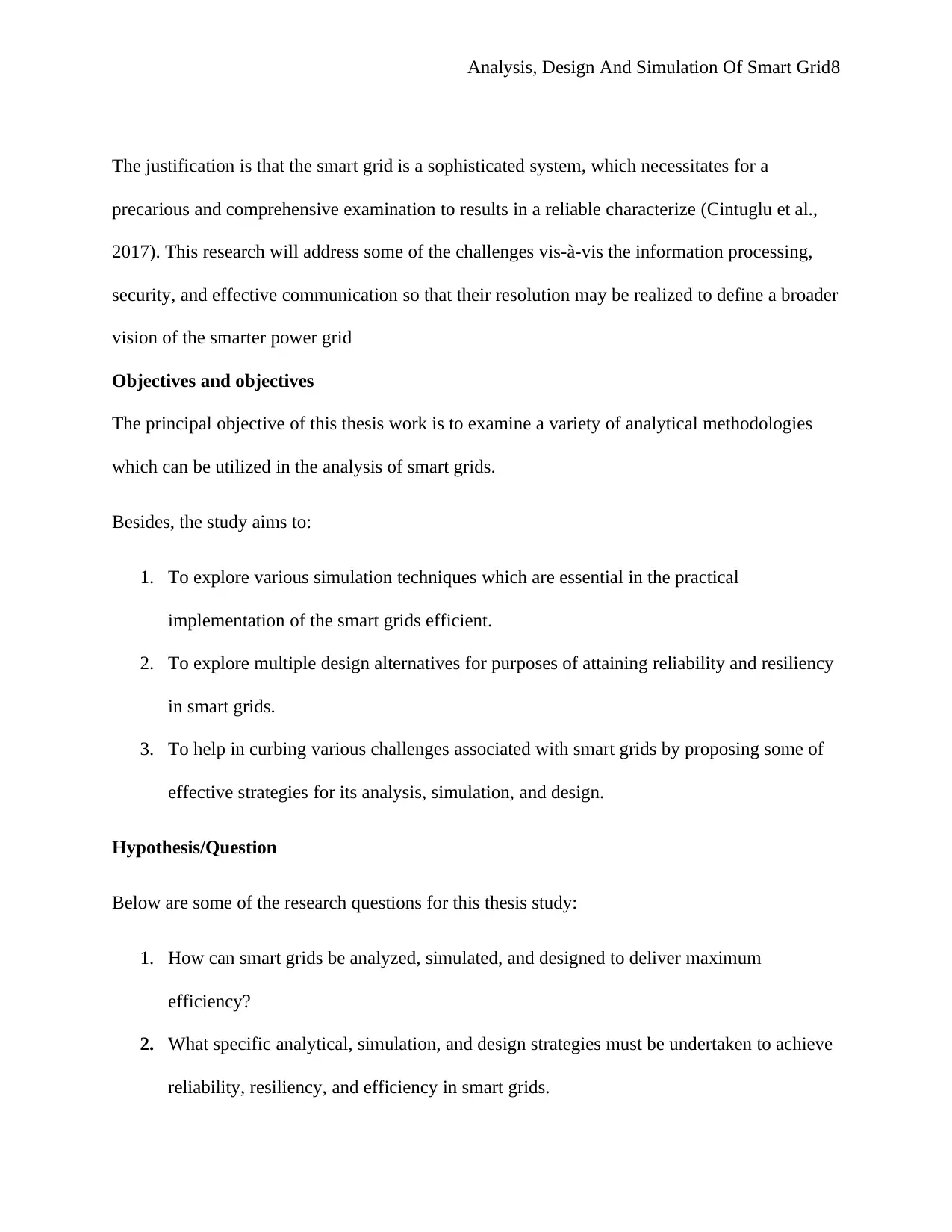
Analysis, Design And Simulation Of Smart Grid8
The justification is that the smart grid is a sophisticated system, which necessitates for a
precarious and comprehensive examination to results in a reliable characterize (Cintuglu et al.,
2017). This research will address some of the challenges vis-à-vis the information processing,
security, and effective communication so that their resolution may be realized to define a broader
vision of the smarter power grid
Objectives and objectives
The principal objective of this thesis work is to examine a variety of analytical methodologies
which can be utilized in the analysis of smart grids.
Besides, the study aims to:
1. To explore various simulation techniques which are essential in the practical
implementation of the smart grids efficient.
2. To explore multiple design alternatives for purposes of attaining reliability and resiliency
in smart grids.
3. To help in curbing various challenges associated with smart grids by proposing some of
effective strategies for its analysis, simulation, and design.
Hypothesis/Question
Below are some of the research questions for this thesis study:
1. How can smart grids be analyzed, simulated, and designed to deliver maximum
efficiency?
2. What specific analytical, simulation, and design strategies must be undertaken to achieve
reliability, resiliency, and efficiency in smart grids.
The justification is that the smart grid is a sophisticated system, which necessitates for a
precarious and comprehensive examination to results in a reliable characterize (Cintuglu et al.,
2017). This research will address some of the challenges vis-à-vis the information processing,
security, and effective communication so that their resolution may be realized to define a broader
vision of the smarter power grid
Objectives and objectives
The principal objective of this thesis work is to examine a variety of analytical methodologies
which can be utilized in the analysis of smart grids.
Besides, the study aims to:
1. To explore various simulation techniques which are essential in the practical
implementation of the smart grids efficient.
2. To explore multiple design alternatives for purposes of attaining reliability and resiliency
in smart grids.
3. To help in curbing various challenges associated with smart grids by proposing some of
effective strategies for its analysis, simulation, and design.
Hypothesis/Question
Below are some of the research questions for this thesis study:
1. How can smart grids be analyzed, simulated, and designed to deliver maximum
efficiency?
2. What specific analytical, simulation, and design strategies must be undertaken to achieve
reliability, resiliency, and efficiency in smart grids.
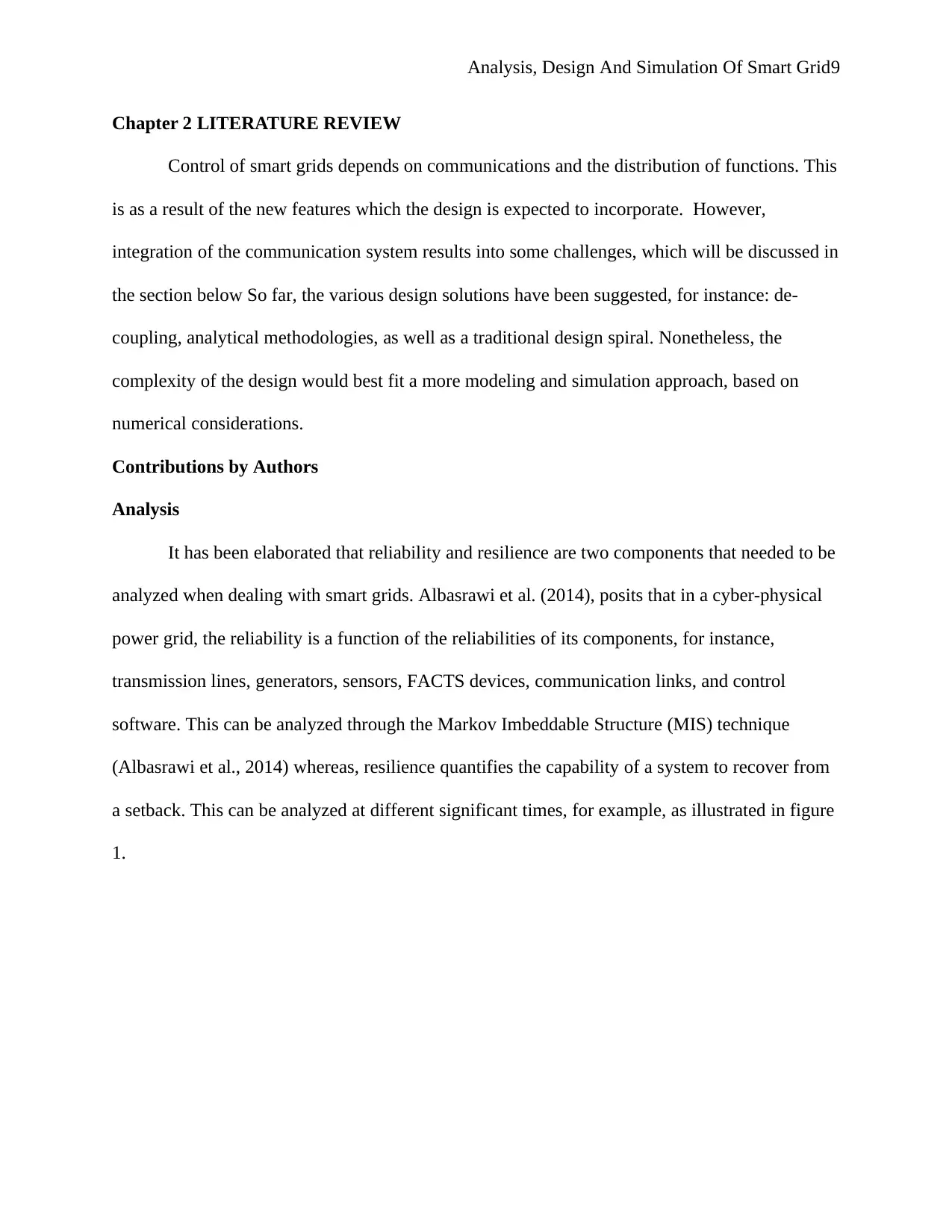
Analysis, Design And Simulation Of Smart Grid9
Chapter 2 LITERATURE REVIEW
Control of smart grids depends on communications and the distribution of functions. This
is as a result of the new features which the design is expected to incorporate. However,
integration of the communication system results into some challenges, which will be discussed in
the section below So far, the various design solutions have been suggested, for instance: de-
coupling, analytical methodologies, as well as a traditional design spiral. Nonetheless, the
complexity of the design would best fit a more modeling and simulation approach, based on
numerical considerations.
Contributions by Authors
Analysis
It has been elaborated that reliability and resilience are two components that needed to be
analyzed when dealing with smart grids. Albasrawi et al. (2014), posits that in a cyber-physical
power grid, the reliability is a function of the reliabilities of its components, for instance,
transmission lines, generators, sensors, FACTS devices, communication links, and control
software. This can be analyzed through the Markov Imbeddable Structure (MIS) technique
(Albasrawi et al., 2014) whereas, resilience quantifies the capability of a system to recover from
a setback. This can be analyzed at different significant times, for example, as illustrated in figure
1.
Chapter 2 LITERATURE REVIEW
Control of smart grids depends on communications and the distribution of functions. This
is as a result of the new features which the design is expected to incorporate. However,
integration of the communication system results into some challenges, which will be discussed in
the section below So far, the various design solutions have been suggested, for instance: de-
coupling, analytical methodologies, as well as a traditional design spiral. Nonetheless, the
complexity of the design would best fit a more modeling and simulation approach, based on
numerical considerations.
Contributions by Authors
Analysis
It has been elaborated that reliability and resilience are two components that needed to be
analyzed when dealing with smart grids. Albasrawi et al. (2014), posits that in a cyber-physical
power grid, the reliability is a function of the reliabilities of its components, for instance,
transmission lines, generators, sensors, FACTS devices, communication links, and control
software. This can be analyzed through the Markov Imbeddable Structure (MIS) technique
(Albasrawi et al., 2014) whereas, resilience quantifies the capability of a system to recover from
a setback. This can be analyzed at different significant times, for example, as illustrated in figure
1.
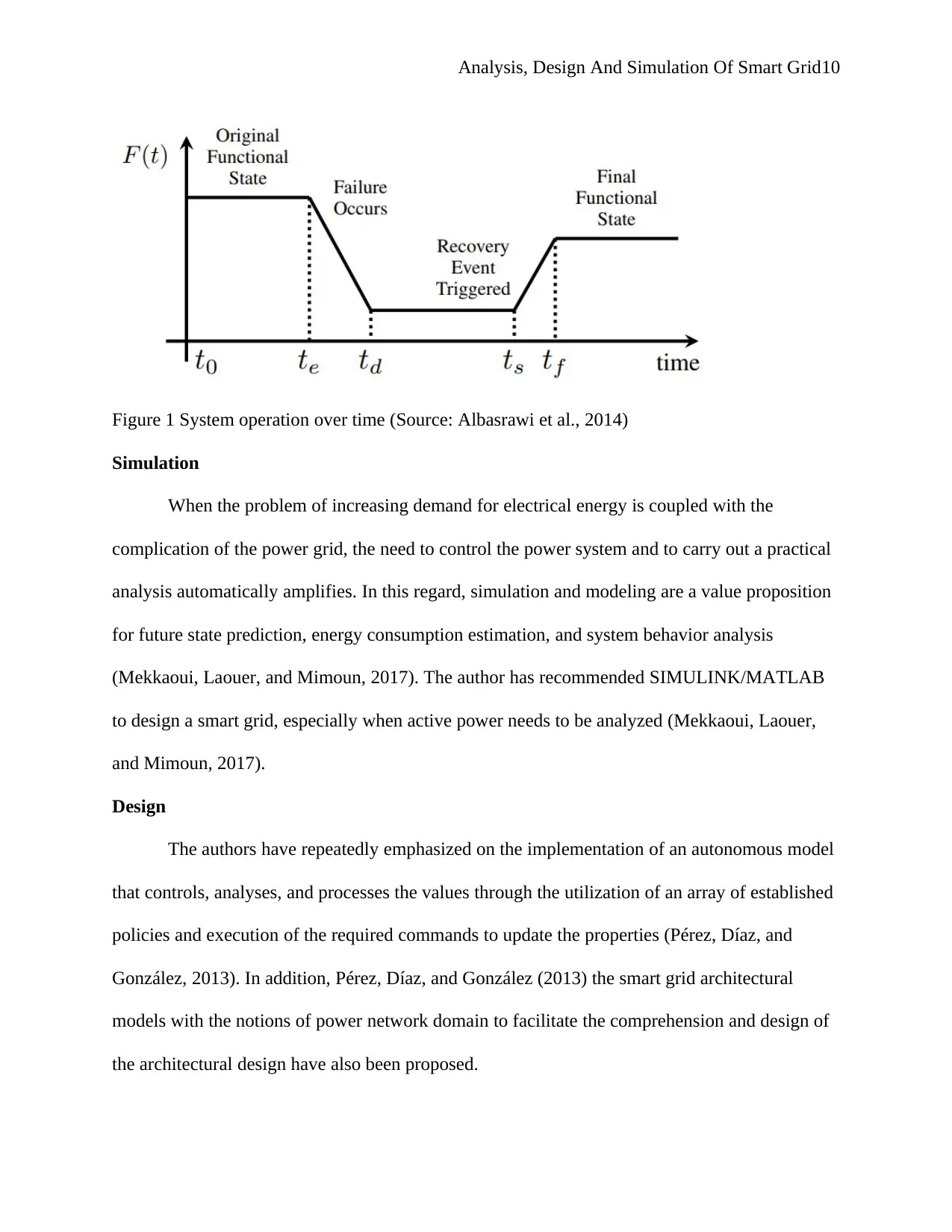
Analysis, Design And Simulation Of Smart Grid10
Figure 1 System operation over time (Source: Albasrawi et al., 2014)
Simulation
When the problem of increasing demand for electrical energy is coupled with the
complication of the power grid, the need to control the power system and to carry out a practical
analysis automatically amplifies. In this regard, simulation and modeling are a value proposition
for future state prediction, energy consumption estimation, and system behavior analysis
(Mekkaoui, Laouer, and Mimoun, 2017). The author has recommended SIMULINK/MATLAB
to design a smart grid, especially when active power needs to be analyzed (Mekkaoui, Laouer,
and Mimoun, 2017).
Design
The authors have repeatedly emphasized on the implementation of an autonomous model
that controls, analyses, and processes the values through the utilization of an array of established
policies and execution of the required commands to update the properties (Pérez, Díaz, and
González, 2013). In addition, Pérez, Díaz, and González (2013) the smart grid architectural
models with the notions of power network domain to facilitate the comprehension and design of
the architectural design have also been proposed.
Figure 1 System operation over time (Source: Albasrawi et al., 2014)
Simulation
When the problem of increasing demand for electrical energy is coupled with the
complication of the power grid, the need to control the power system and to carry out a practical
analysis automatically amplifies. In this regard, simulation and modeling are a value proposition
for future state prediction, energy consumption estimation, and system behavior analysis
(Mekkaoui, Laouer, and Mimoun, 2017). The author has recommended SIMULINK/MATLAB
to design a smart grid, especially when active power needs to be analyzed (Mekkaoui, Laouer,
and Mimoun, 2017).
Design
The authors have repeatedly emphasized on the implementation of an autonomous model
that controls, analyses, and processes the values through the utilization of an array of established
policies and execution of the required commands to update the properties (Pérez, Díaz, and
González, 2013). In addition, Pérez, Díaz, and González (2013) the smart grid architectural
models with the notions of power network domain to facilitate the comprehension and design of
the architectural design have also been proposed.
Secure Best Marks with AI Grader
Need help grading? Try our AI Grader for instant feedback on your assignments.

Analysis, Design And Simulation Of Smart Grid11
Knowledge Gap
Despite the fact that smart grids are not a novel invention, numerous knowledge gaps
exist with regards to it. For instance, the authors have identified a variety of challenges that come
up with the analysis, simulation, and design of smart grids but none of them have been able to
come up with a concrete solution that eliminates, or at least, mitigates the identified deficiencies
(Marashi and Sarvestani, 2017). However, this research will look to bridge this gap by carrying
out a comprehensive literature review and subsequently recommending the best techniques that
one can utilize to churn out desired levels of reliability, resilience, and efficiency from the smart
grid system.
Smart grid simulation challenges
Communication
Talking of a smart grid, the control functions need to be regulated, as well as strict
monitoring is done in the coordination of its components. This implies that the performance of
the system will be regarding the communication infrastructure system. The power and control
reactions of the smart grid can be potentially influenced by elements such as packet loss, time
delay, packet corruption, jittering, packet re-ordering, and disconnections. Therefore, the
simulation of the communication and coupled powered components needs to be thoroughly
considered in the design stage
Multi-technology
Dynamic interactions affect the smart grid, and it should be incorporated during the smart
grid simulation process. The dynamic interactions refer to the interaction between the domains,
as well as the ability of the system to timely respond or react. For example, the interaction of gas
Knowledge Gap
Despite the fact that smart grids are not a novel invention, numerous knowledge gaps
exist with regards to it. For instance, the authors have identified a variety of challenges that come
up with the analysis, simulation, and design of smart grids but none of them have been able to
come up with a concrete solution that eliminates, or at least, mitigates the identified deficiencies
(Marashi and Sarvestani, 2017). However, this research will look to bridge this gap by carrying
out a comprehensive literature review and subsequently recommending the best techniques that
one can utilize to churn out desired levels of reliability, resilience, and efficiency from the smart
grid system.
Smart grid simulation challenges
Communication
Talking of a smart grid, the control functions need to be regulated, as well as strict
monitoring is done in the coordination of its components. This implies that the performance of
the system will be regarding the communication infrastructure system. The power and control
reactions of the smart grid can be potentially influenced by elements such as packet loss, time
delay, packet corruption, jittering, packet re-ordering, and disconnections. Therefore, the
simulation of the communication and coupled powered components needs to be thoroughly
considered in the design stage
Multi-technology
Dynamic interactions affect the smart grid, and it should be incorporated during the smart
grid simulation process. The dynamic interactions refer to the interaction between the domains,
as well as the ability of the system to timely respond or react. For example, the interaction of gas

Analysis, Design And Simulation Of Smart Grid12
and electrical components, that are coupled physically at the power and heat units but then
regulated in the demand side management.
Stochastic
The effects arising from Stochastic are essential in the design of the smart grids. This is
primarily as a result of the effects of the communication networks and the volatility of various
new energy sources. These phenomena are extensions of the already existing conventional
power networks emanating from the behavior of the load.
Device testing
During the design device testing, some disparities are anticipated; besides, the field
conditions also influence the overall design specifications that are generated. Guaranteeing large
margins or oversizing of the dimension cannot result in compensation of these mismatches, as it
eventually results in rapid scaling up that eventually results in unfeasibility. By extension,
testing of the device within the system itself may not be sufficient enough. Thus, the testing
requires realistic settings before deployment, implying a necessity of power and signal
connection mode.
Simulation Environments
Designing of a smart grid system requires some suitable conditions, and sufficient
amount of information gathered in the past with regards to some of the appropriate conditions is
available. The environments are well established in order to allow for real-time simulations to be
undertaken. They include
Co-simulation desktop
There exist multiple systems which need to be dynamically coup0led with another system
via means of simulations. These simulations need to be synchronized as well and in various
and electrical components, that are coupled physically at the power and heat units but then
regulated in the demand side management.
Stochastic
The effects arising from Stochastic are essential in the design of the smart grids. This is
primarily as a result of the effects of the communication networks and the volatility of various
new energy sources. These phenomena are extensions of the already existing conventional
power networks emanating from the behavior of the load.
Device testing
During the design device testing, some disparities are anticipated; besides, the field
conditions also influence the overall design specifications that are generated. Guaranteeing large
margins or oversizing of the dimension cannot result in compensation of these mismatches, as it
eventually results in rapid scaling up that eventually results in unfeasibility. By extension,
testing of the device within the system itself may not be sufficient enough. Thus, the testing
requires realistic settings before deployment, implying a necessity of power and signal
connection mode.
Simulation Environments
Designing of a smart grid system requires some suitable conditions, and sufficient
amount of information gathered in the past with regards to some of the appropriate conditions is
available. The environments are well established in order to allow for real-time simulations to be
undertaken. They include
Co-simulation desktop
There exist multiple systems which need to be dynamically coup0led with another system
via means of simulations. These simulations need to be synchronized as well and in various

Analysis, Design And Simulation Of Smart Grid13
environments. To achieve this, co-simulation would be best appropriate. It makes it conducive
for suitable environments and the application of the systems. The smart grid system needs a co-
simulation of both the communication and power system. Despite having various methods,
VPNET is mostly recommended. It does the simulation of the communication and power system
infrastructure in VPNET and OPNET, respectively. Initially, these techniques were
recommended for closed loop systems, but then it has been established for control signals which
depend on the exchange of information, for instance, gathering of raw data.
HIL/PHIL
HIL techniques are limited to control equipment test, where they only allow coupling of
signals between the physical device under test and the rime simulate. This is accompanied by
various significant limitations, which bring about the aspect of a modified version, known as
PHIL, in this technology, energy is forced at the device under test terminals and the simulated
system portion.
Energy emulation
To test equipment’s rated at 25kva, a specific test and flexible power equipment has been
designed known as (FLePs). Currently, this interface has had its application on various platforms
such as testing of multi-technology devices for cooling and heating.
Communication emulation
In an actual simulation of the communication and power networks, HIL testing platforms
of the networked controllers has to be enabled. So far. RTDS has been suggested for the
simulation in a WANem software. The diagram below shoes the FLePs PHIL interface in
context.
environments. To achieve this, co-simulation would be best appropriate. It makes it conducive
for suitable environments and the application of the systems. The smart grid system needs a co-
simulation of both the communication and power system. Despite having various methods,
VPNET is mostly recommended. It does the simulation of the communication and power system
infrastructure in VPNET and OPNET, respectively. Initially, these techniques were
recommended for closed loop systems, but then it has been established for control signals which
depend on the exchange of information, for instance, gathering of raw data.
HIL/PHIL
HIL techniques are limited to control equipment test, where they only allow coupling of
signals between the physical device under test and the rime simulate. This is accompanied by
various significant limitations, which bring about the aspect of a modified version, known as
PHIL, in this technology, energy is forced at the device under test terminals and the simulated
system portion.
Energy emulation
To test equipment’s rated at 25kva, a specific test and flexible power equipment has been
designed known as (FLePs). Currently, this interface has had its application on various platforms
such as testing of multi-technology devices for cooling and heating.
Communication emulation
In an actual simulation of the communication and power networks, HIL testing platforms
of the networked controllers has to be enabled. So far. RTDS has been suggested for the
simulation in a WANem software. The diagram below shoes the FLePs PHIL interface in
context.
Paraphrase This Document
Need a fresh take? Get an instant paraphrase of this document with our AI Paraphraser
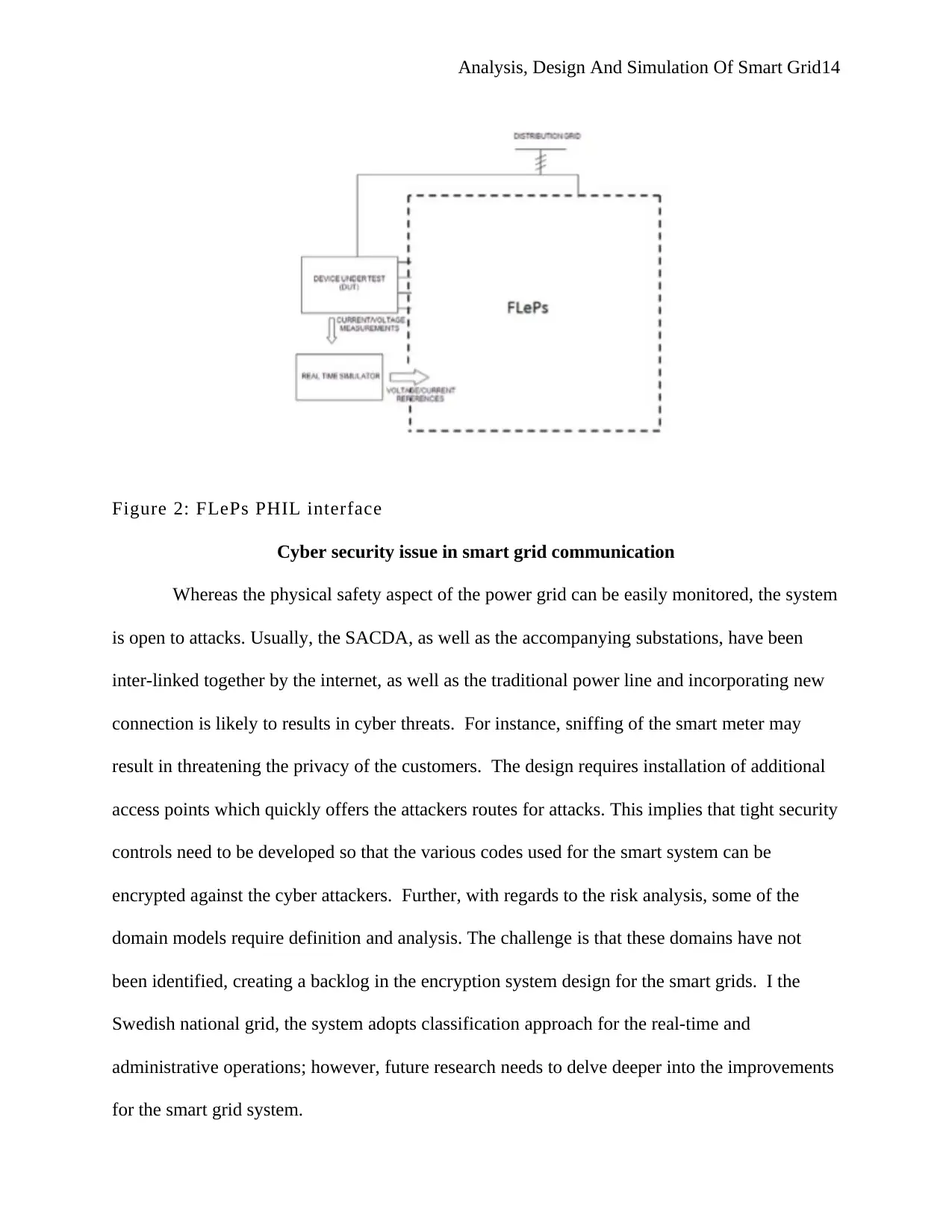
Analysis, Design And Simulation Of Smart Grid14
Figure 2: FLePs PHIL interface
Cyber security issue in smart grid communication
Whereas the physical safety aspect of the power grid can be easily monitored, the system
is open to attacks. Usually, the SACDA, as well as the accompanying substations, have been
inter-linked together by the internet, as well as the traditional power line and incorporating new
connection is likely to results in cyber threats. For instance, sniffing of the smart meter may
result in threatening the privacy of the customers. The design requires installation of additional
access points which quickly offers the attackers routes for attacks. This implies that tight security
controls need to be developed so that the various codes used for the smart system can be
encrypted against the cyber attackers. Further, with regards to the risk analysis, some of the
domain models require definition and analysis. The challenge is that these domains have not
been identified, creating a backlog in the encryption system design for the smart grids. I the
Swedish national grid, the system adopts classification approach for the real-time and
administrative operations; however, future research needs to delve deeper into the improvements
for the smart grid system.
Figure 2: FLePs PHIL interface
Cyber security issue in smart grid communication
Whereas the physical safety aspect of the power grid can be easily monitored, the system
is open to attacks. Usually, the SACDA, as well as the accompanying substations, have been
inter-linked together by the internet, as well as the traditional power line and incorporating new
connection is likely to results in cyber threats. For instance, sniffing of the smart meter may
result in threatening the privacy of the customers. The design requires installation of additional
access points which quickly offers the attackers routes for attacks. This implies that tight security
controls need to be developed so that the various codes used for the smart system can be
encrypted against the cyber attackers. Further, with regards to the risk analysis, some of the
domain models require definition and analysis. The challenge is that these domains have not
been identified, creating a backlog in the encryption system design for the smart grids. I the
Swedish national grid, the system adopts classification approach for the real-time and
administrative operations; however, future research needs to delve deeper into the improvements
for the smart grid system.
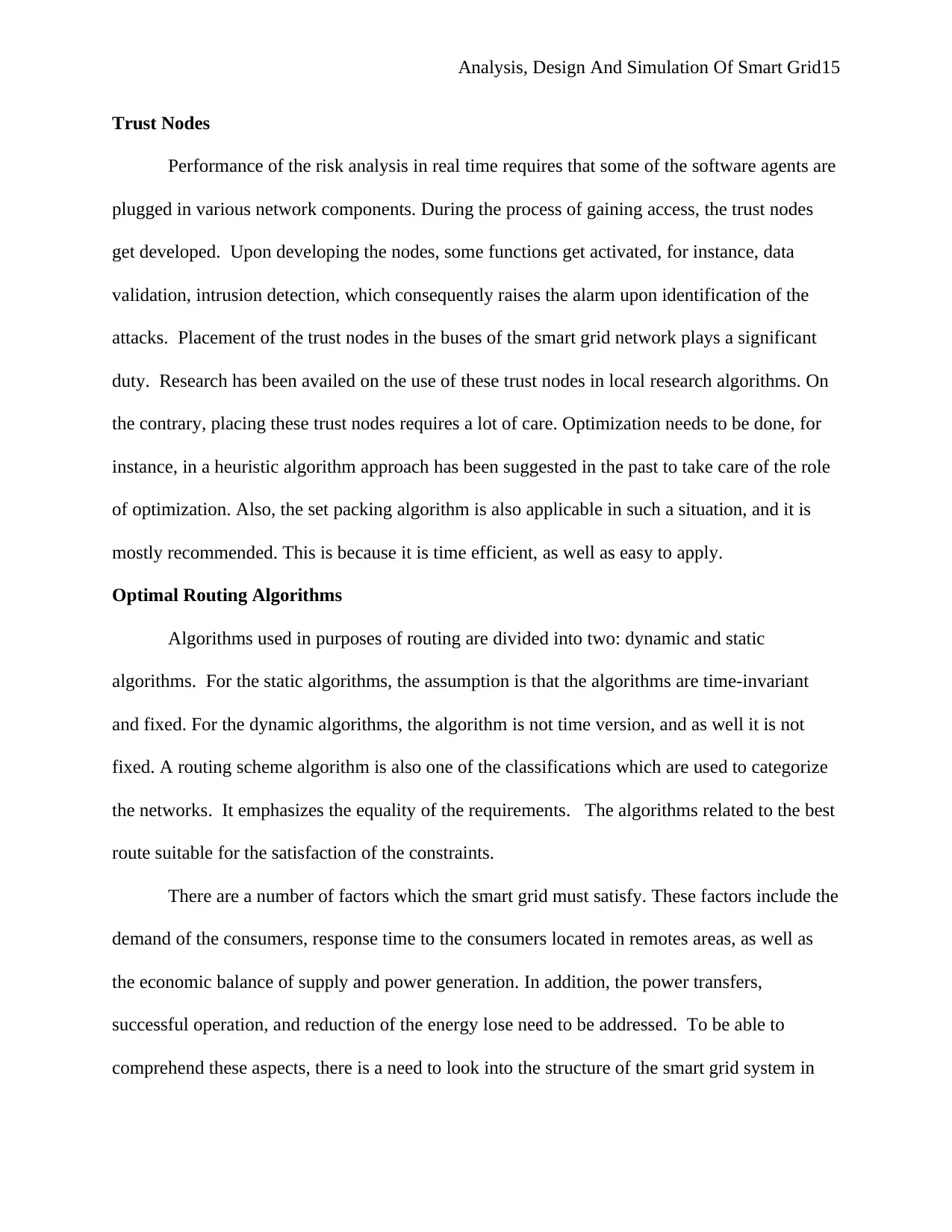
Analysis, Design And Simulation Of Smart Grid15
Trust Nodes
Performance of the risk analysis in real time requires that some of the software agents are
plugged in various network components. During the process of gaining access, the trust nodes
get developed. Upon developing the nodes, some functions get activated, for instance, data
validation, intrusion detection, which consequently raises the alarm upon identification of the
attacks. Placement of the trust nodes in the buses of the smart grid network plays a significant
duty. Research has been availed on the use of these trust nodes in local research algorithms. On
the contrary, placing these trust nodes requires a lot of care. Optimization needs to be done, for
instance, in a heuristic algorithm approach has been suggested in the past to take care of the role
of optimization. Also, the set packing algorithm is also applicable in such a situation, and it is
mostly recommended. This is because it is time efficient, as well as easy to apply.
Optimal Routing Algorithms
Algorithms used in purposes of routing are divided into two: dynamic and static
algorithms. For the static algorithms, the assumption is that the algorithms are time-invariant
and fixed. For the dynamic algorithms, the algorithm is not time version, and as well it is not
fixed. A routing scheme algorithm is also one of the classifications which are used to categorize
the networks. It emphasizes the equality of the requirements. The algorithms related to the best
route suitable for the satisfaction of the constraints.
There are a number of factors which the smart grid must satisfy. These factors include the
demand of the consumers, response time to the consumers located in remotes areas, as well as
the economic balance of supply and power generation. In addition, the power transfers,
successful operation, and reduction of the energy lose need to be addressed. To be able to
comprehend these aspects, there is a need to look into the structure of the smart grid system in
Trust Nodes
Performance of the risk analysis in real time requires that some of the software agents are
plugged in various network components. During the process of gaining access, the trust nodes
get developed. Upon developing the nodes, some functions get activated, for instance, data
validation, intrusion detection, which consequently raises the alarm upon identification of the
attacks. Placement of the trust nodes in the buses of the smart grid network plays a significant
duty. Research has been availed on the use of these trust nodes in local research algorithms. On
the contrary, placing these trust nodes requires a lot of care. Optimization needs to be done, for
instance, in a heuristic algorithm approach has been suggested in the past to take care of the role
of optimization. Also, the set packing algorithm is also applicable in such a situation, and it is
mostly recommended. This is because it is time efficient, as well as easy to apply.
Optimal Routing Algorithms
Algorithms used in purposes of routing are divided into two: dynamic and static
algorithms. For the static algorithms, the assumption is that the algorithms are time-invariant
and fixed. For the dynamic algorithms, the algorithm is not time version, and as well it is not
fixed. A routing scheme algorithm is also one of the classifications which are used to categorize
the networks. It emphasizes the equality of the requirements. The algorithms related to the best
route suitable for the satisfaction of the constraints.
There are a number of factors which the smart grid must satisfy. These factors include the
demand of the consumers, response time to the consumers located in remotes areas, as well as
the economic balance of supply and power generation. In addition, the power transfers,
successful operation, and reduction of the energy lose need to be addressed. To be able to
comprehend these aspects, there is a need to look into the structure of the smart grid system in
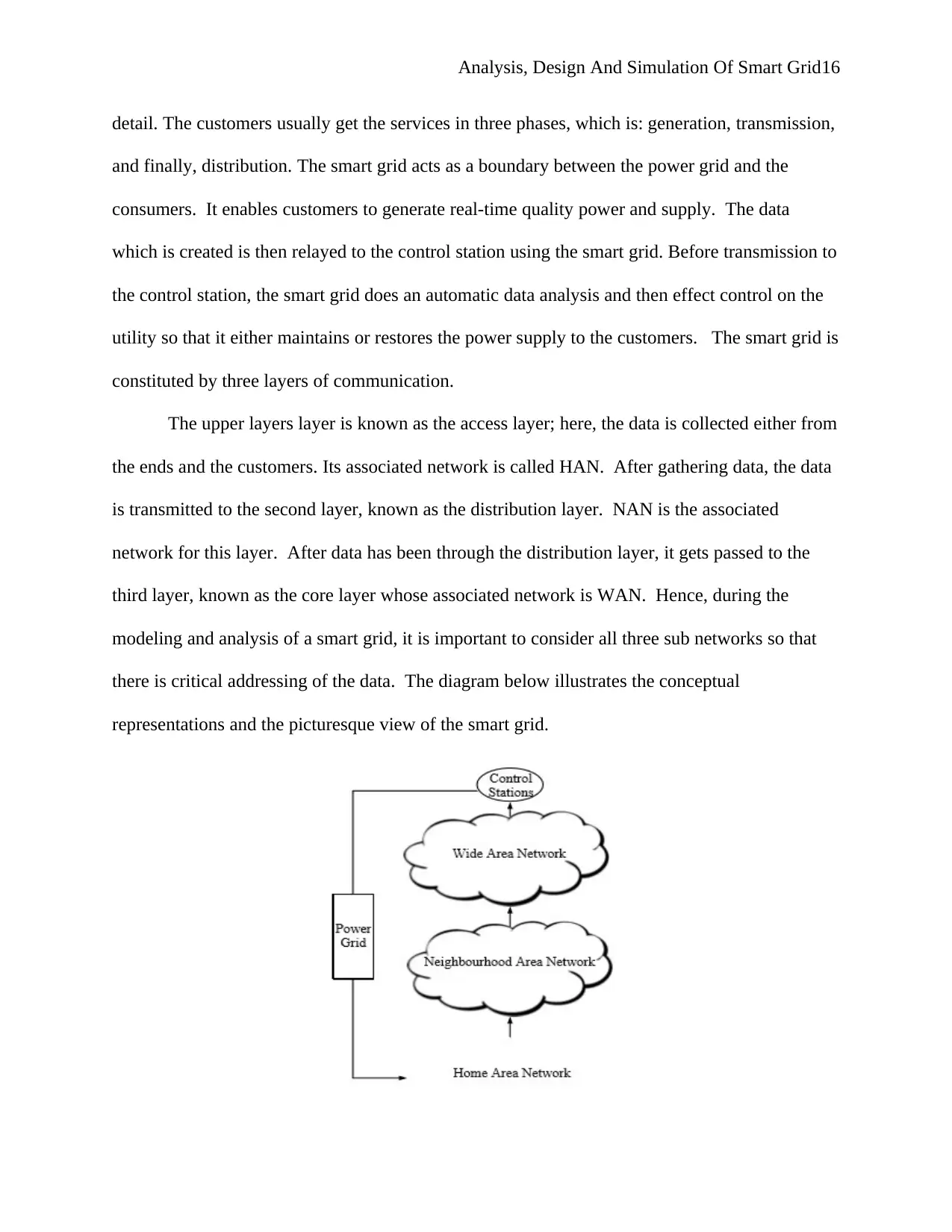
Analysis, Design And Simulation Of Smart Grid16
detail. The customers usually get the services in three phases, which is: generation, transmission,
and finally, distribution. The smart grid acts as a boundary between the power grid and the
consumers. It enables customers to generate real-time quality power and supply. The data
which is created is then relayed to the control station using the smart grid. Before transmission to
the control station, the smart grid does an automatic data analysis and then effect control on the
utility so that it either maintains or restores the power supply to the customers. The smart grid is
constituted by three layers of communication.
The upper layers layer is known as the access layer; here, the data is collected either from
the ends and the customers. Its associated network is called HAN. After gathering data, the data
is transmitted to the second layer, known as the distribution layer. NAN is the associated
network for this layer. After data has been through the distribution layer, it gets passed to the
third layer, known as the core layer whose associated network is WAN. Hence, during the
modeling and analysis of a smart grid, it is important to consider all three sub networks so that
there is critical addressing of the data. The diagram below illustrates the conceptual
representations and the picturesque view of the smart grid.
detail. The customers usually get the services in three phases, which is: generation, transmission,
and finally, distribution. The smart grid acts as a boundary between the power grid and the
consumers. It enables customers to generate real-time quality power and supply. The data
which is created is then relayed to the control station using the smart grid. Before transmission to
the control station, the smart grid does an automatic data analysis and then effect control on the
utility so that it either maintains or restores the power supply to the customers. The smart grid is
constituted by three layers of communication.
The upper layers layer is known as the access layer; here, the data is collected either from
the ends and the customers. Its associated network is called HAN. After gathering data, the data
is transmitted to the second layer, known as the distribution layer. NAN is the associated
network for this layer. After data has been through the distribution layer, it gets passed to the
third layer, known as the core layer whose associated network is WAN. Hence, during the
modeling and analysis of a smart grid, it is important to consider all three sub networks so that
there is critical addressing of the data. The diagram below illustrates the conceptual
representations and the picturesque view of the smart grid.
Secure Best Marks with AI Grader
Need help grading? Try our AI Grader for instant feedback on your assignments.
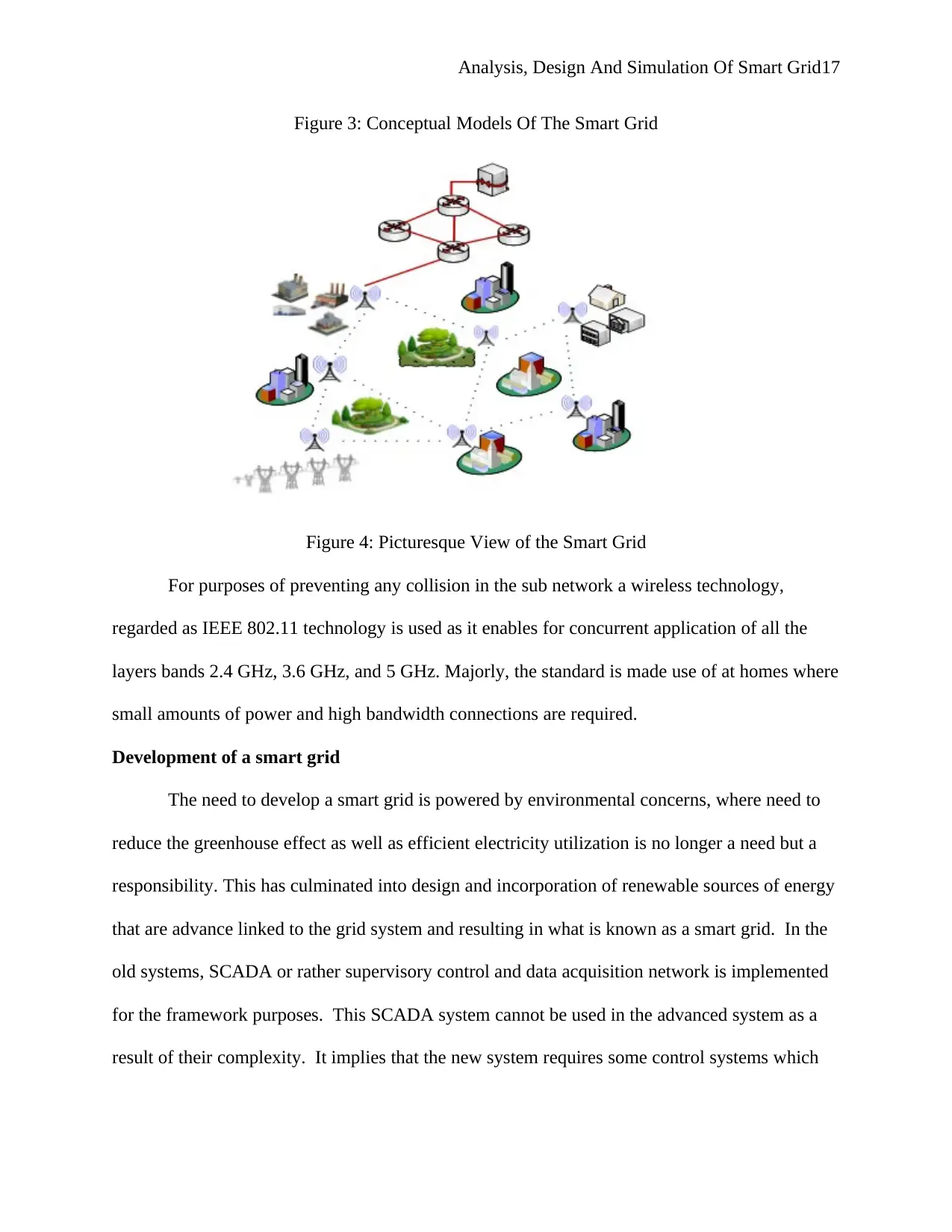
Analysis, Design And Simulation Of Smart Grid17
Figure 3: Conceptual Models Of The Smart Grid
Figure 4: Picturesque View of the Smart Grid
For purposes of preventing any collision in the sub network a wireless technology,
regarded as IEEE 802.11 technology is used as it enables for concurrent application of all the
layers bands 2.4 GHz, 3.6 GHz, and 5 GHz. Majorly, the standard is made use of at homes where
small amounts of power and high bandwidth connections are required.
Development of a smart grid
The need to develop a smart grid is powered by environmental concerns, where need to
reduce the greenhouse effect as well as efficient electricity utilization is no longer a need but a
responsibility. This has culminated into design and incorporation of renewable sources of energy
that are advance linked to the grid system and resulting in what is known as a smart grid. In the
old systems, SCADA or rather supervisory control and data acquisition network is implemented
for the framework purposes. This SCADA system cannot be used in the advanced system as a
result of their complexity. It implies that the new system requires some control systems which
Figure 3: Conceptual Models Of The Smart Grid
Figure 4: Picturesque View of the Smart Grid
For purposes of preventing any collision in the sub network a wireless technology,
regarded as IEEE 802.11 technology is used as it enables for concurrent application of all the
layers bands 2.4 GHz, 3.6 GHz, and 5 GHz. Majorly, the standard is made use of at homes where
small amounts of power and high bandwidth connections are required.
Development of a smart grid
The need to develop a smart grid is powered by environmental concerns, where need to
reduce the greenhouse effect as well as efficient electricity utilization is no longer a need but a
responsibility. This has culminated into design and incorporation of renewable sources of energy
that are advance linked to the grid system and resulting in what is known as a smart grid. In the
old systems, SCADA or rather supervisory control and data acquisition network is implemented
for the framework purposes. This SCADA system cannot be used in the advanced system as a
result of their complexity. It implies that the new system requires some control systems which

Analysis, Design And Simulation Of Smart Grid18
have to communicate or link to a central system which performs regulatory action of the entire
system.
The power demand from the customers, as well as the continuously varying renewable
energy sources, has an overall consequence on the smart grid and its process relies on the
infrastructure of the communication networks. Previous studies have suggested a co-simulation
that is in charge of monitoring the systems. Currently, there is no documented information 8in in
accordance to the best appropriate co-simulation software. By extension, the design of the smart
grid creates a challenge towards ensuring that the objectives are met.
Co-simulation equipment
For the co-simulator equipment, there exist two components, which is a communication
network simulator and a power system simulator which have to exchange data within themselves
in order to generate the real-time action.
Power system simulator
Below are the components of the power system accumulator
Transient stability
Load flow
System impact as a component of clean energy
Protection
Reliability
Optimal dispatch for unit generation
Reactive power planning
Transmission for the optimal power flow.
have to communicate or link to a central system which performs regulatory action of the entire
system.
The power demand from the customers, as well as the continuously varying renewable
energy sources, has an overall consequence on the smart grid and its process relies on the
infrastructure of the communication networks. Previous studies have suggested a co-simulation
that is in charge of monitoring the systems. Currently, there is no documented information 8in in
accordance to the best appropriate co-simulation software. By extension, the design of the smart
grid creates a challenge towards ensuring that the objectives are met.
Co-simulation equipment
For the co-simulator equipment, there exist two components, which is a communication
network simulator and a power system simulator which have to exchange data within themselves
in order to generate the real-time action.
Power system simulator
Below are the components of the power system accumulator
Transient stability
Load flow
System impact as a component of clean energy
Protection
Reliability
Optimal dispatch for unit generation
Reactive power planning
Transmission for the optimal power flow.

Analysis, Design And Simulation Of Smart Grid19
On the other hand, for the communications network simulator, it has to comprise of data
transmission protocols and various network connection. They include
Wan
Wi-Fi
GSM
ZigBee
UTP
LAN
LTE
3G
TCP/IP
WiMax
The developments of a simulator are costly and sophisticated, thus the existing literature
relies just on technical data fem the software. The communication network simulator is designed
or somewhat demonstrated as a separate system, whereas for the power system simulator has to
be modeled as a continuous system.
One primary task during the design of these simulators is the resolution of the interface
software. Packages. It necessities for a framework to facilitate the transfer of data between the
two software. This implies that synchronization of time is of great essence since delay from data
containing signals may result in a catastrophic situation. The synchronization will thus require a
synchronization engine which will aid in ensuring the activity. An analysis of the response of
On the other hand, for the communications network simulator, it has to comprise of data
transmission protocols and various network connection. They include
Wan
Wi-Fi
GSM
ZigBee
UTP
LAN
LTE
3G
TCP/IP
WiMax
The developments of a simulator are costly and sophisticated, thus the existing literature
relies just on technical data fem the software. The communication network simulator is designed
or somewhat demonstrated as a separate system, whereas for the power system simulator has to
be modeled as a continuous system.
One primary task during the design of these simulators is the resolution of the interface
software. Packages. It necessities for a framework to facilitate the transfer of data between the
two software. This implies that synchronization of time is of great essence since delay from data
containing signals may result in a catastrophic situation. The synchronization will thus require a
synchronization engine which will aid in ensuring the activity. An analysis of the response of
Paraphrase This Document
Need a fresh take? Get an instant paraphrase of this document with our AI Paraphraser

Analysis, Design And Simulation Of Smart Grid20
the simulators with respect to the smart grid can be done; however, it remains clear that the
design of the system is very complicated and requires a lot of time and resources.
Software implementation
For the case of simulation of both the network and the power system, commercial tools,
as well as open sources, are very much in plenty. Some of the systems which exists includes
Modelica [1,7], PSLF [3], PSS/E [8], GE-PSLF [9], MATLAB [5,6] and PSCAD/EMTSDC
[10,11]. The above is for the power system simulators. Contrarily, the network communication
simulator s includes, but are not limited to NS2 (open source developed by UC Berkley) [1-3],
OMNet [5, 7] and OPNET [12, 13].
Power system simulator
As stated earlier, modeling of this simulator is characterized by continues operations. In
a computer system, modeling of the power system is sampled, and then an evaluation is done in
regular intervals; moreover, it is still a continuous system. For the sample simulation that will be
performed, PSCAD/EMTDC will be implemented in the power system simulation. The users
will be able to define the models of the components which they adopt for the system. The
PSCAD/EMTDC will as well offer two routines, including DSCOUT and DSYDYN. Which
will interface between each other? The interface of the two routines is a crucial aspect of the
design since there is the need to stop the simulation and the installation of other control
parameters done in order to respond to the specific event during simulation resolution.
The two routines; DSDYN and DSOUT; makes it easier and feasible or the defining of the smart
grid system in a transparent manner. They not only enable the control of the input and output
variables concurrently but also offer access for the monitoring and control of the variables.
the simulators with respect to the smart grid can be done; however, it remains clear that the
design of the system is very complicated and requires a lot of time and resources.
Software implementation
For the case of simulation of both the network and the power system, commercial tools,
as well as open sources, are very much in plenty. Some of the systems which exists includes
Modelica [1,7], PSLF [3], PSS/E [8], GE-PSLF [9], MATLAB [5,6] and PSCAD/EMTSDC
[10,11]. The above is for the power system simulators. Contrarily, the network communication
simulator s includes, but are not limited to NS2 (open source developed by UC Berkley) [1-3],
OMNet [5, 7] and OPNET [12, 13].
Power system simulator
As stated earlier, modeling of this simulator is characterized by continues operations. In
a computer system, modeling of the power system is sampled, and then an evaluation is done in
regular intervals; moreover, it is still a continuous system. For the sample simulation that will be
performed, PSCAD/EMTDC will be implemented in the power system simulation. The users
will be able to define the models of the components which they adopt for the system. The
PSCAD/EMTDC will as well offer two routines, including DSCOUT and DSYDYN. Which
will interface between each other? The interface of the two routines is a crucial aspect of the
design since there is the need to stop the simulation and the installation of other control
parameters done in order to respond to the specific event during simulation resolution.
The two routines; DSDYN and DSOUT; makes it easier and feasible or the defining of the smart
grid system in a transparent manner. They not only enable the control of the input and output
variables concurrently but also offer access for the monitoring and control of the variables.

Analysis, Design And Simulation Of Smart Grid21
In the sections to follow, a diagram of the interface of the two routines: DSDYN and DSOUT
will be illustrated.
Figure 5: Interface of DSDYN and DSOUT
Communication network simulator
Smart grid has to make use of the public network as it is very much certain factor. Since
there is a high distribution of the network in terms of the free loads and the energy sources, the
components have to be linked to a communication access point such as WAN, LAN, Wi-Fi or
can as well be via a wireless means such as 3g technology. The network traffic and the rooting
path utilized determines the latency delay, which will be available at the grid component.
In the sections to follow, a diagram of the interface of the two routines: DSDYN and DSOUT
will be illustrated.
Figure 5: Interface of DSDYN and DSOUT
Communication network simulator
Smart grid has to make use of the public network as it is very much certain factor. Since
there is a high distribution of the network in terms of the free loads and the energy sources, the
components have to be linked to a communication access point such as WAN, LAN, Wi-Fi or
can as well be via a wireless means such as 3g technology. The network traffic and the rooting
path utilized determines the latency delay, which will be available at the grid component.
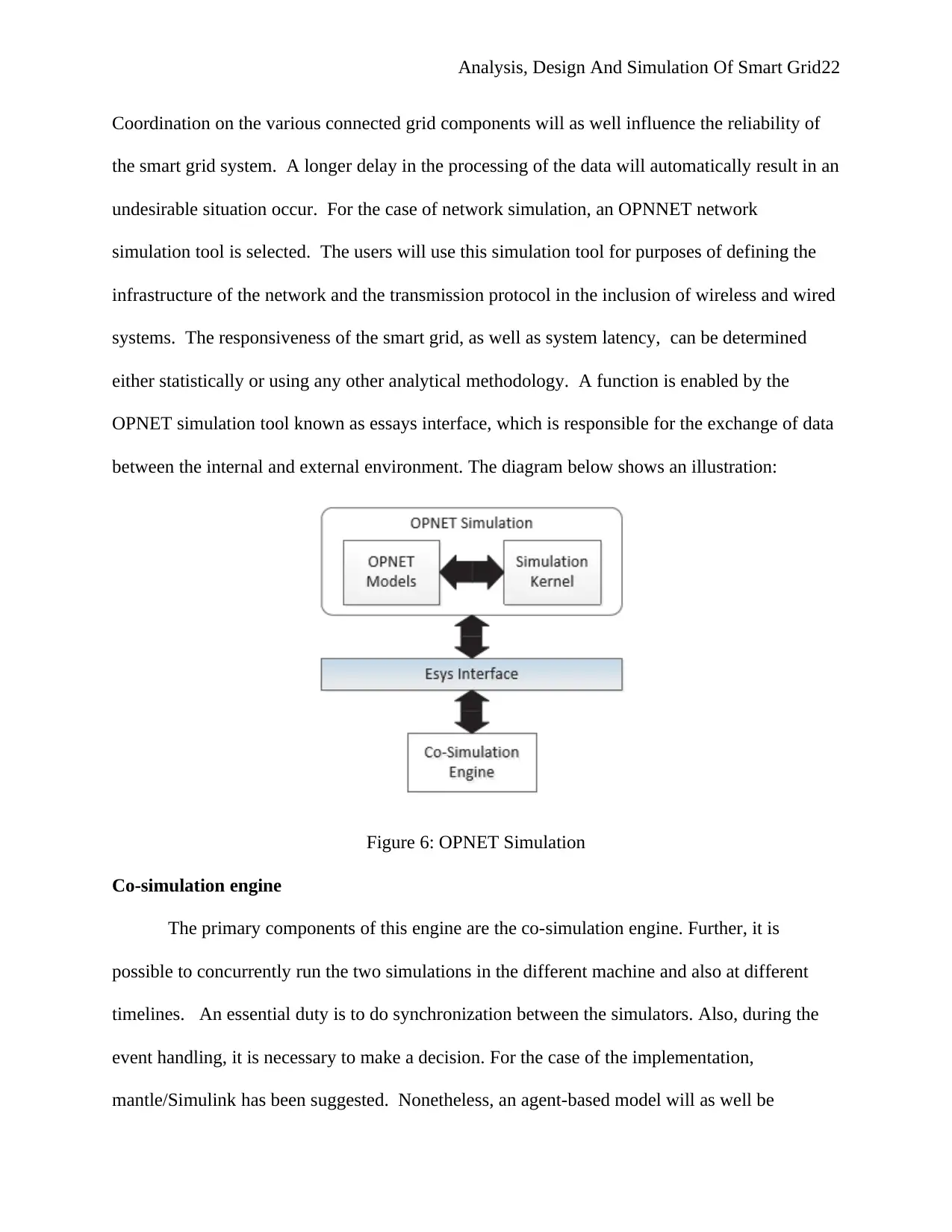
Analysis, Design And Simulation Of Smart Grid22
Coordination on the various connected grid components will as well influence the reliability of
the smart grid system. A longer delay in the processing of the data will automatically result in an
undesirable situation occur. For the case of network simulation, an OPNNET network
simulation tool is selected. The users will use this simulation tool for purposes of defining the
infrastructure of the network and the transmission protocol in the inclusion of wireless and wired
systems. The responsiveness of the smart grid, as well as system latency, can be determined
either statistically or using any other analytical methodology. A function is enabled by the
OPNET simulation tool known as essays interface, which is responsible for the exchange of data
between the internal and external environment. The diagram below shows an illustration:
Figure 6: OPNET Simulation
Co-simulation engine
The primary components of this engine are the co-simulation engine. Further, it is
possible to concurrently run the two simulations in the different machine and also at different
timelines. An essential duty is to do synchronization between the simulators. Also, during the
event handling, it is necessary to make a decision. For the case of the implementation,
mantle/Simulink has been suggested. Nonetheless, an agent-based model will as well be
Coordination on the various connected grid components will as well influence the reliability of
the smart grid system. A longer delay in the processing of the data will automatically result in an
undesirable situation occur. For the case of network simulation, an OPNNET network
simulation tool is selected. The users will use this simulation tool for purposes of defining the
infrastructure of the network and the transmission protocol in the inclusion of wireless and wired
systems. The responsiveness of the smart grid, as well as system latency, can be determined
either statistically or using any other analytical methodology. A function is enabled by the
OPNET simulation tool known as essays interface, which is responsible for the exchange of data
between the internal and external environment. The diagram below shows an illustration:
Figure 6: OPNET Simulation
Co-simulation engine
The primary components of this engine are the co-simulation engine. Further, it is
possible to concurrently run the two simulations in the different machine and also at different
timelines. An essential duty is to do synchronization between the simulators. Also, during the
event handling, it is necessary to make a decision. For the case of the implementation,
mantle/Simulink has been suggested. Nonetheless, an agent-based model will as well be
Secure Best Marks with AI Grader
Need help grading? Try our AI Grader for instant feedback on your assignments.
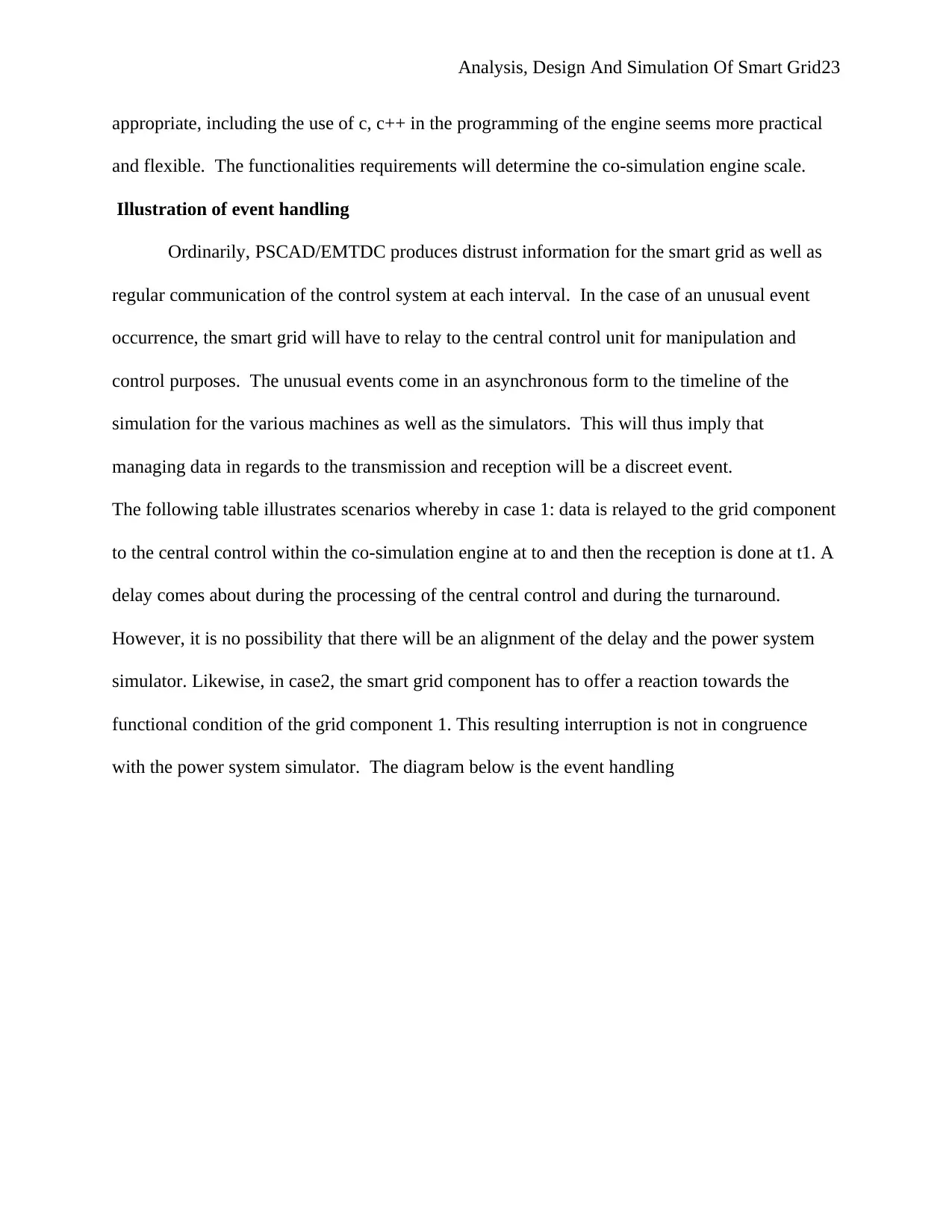
Analysis, Design And Simulation Of Smart Grid23
appropriate, including the use of c, c++ in the programming of the engine seems more practical
and flexible. The functionalities requirements will determine the co-simulation engine scale.
Illustration of event handling
Ordinarily, PSCAD/EMTDC produces distrust information for the smart grid as well as
regular communication of the control system at each interval. In the case of an unusual event
occurrence, the smart grid will have to relay to the central control unit for manipulation and
control purposes. The unusual events come in an asynchronous form to the timeline of the
simulation for the various machines as well as the simulators. This will thus imply that
managing data in regards to the transmission and reception will be a discreet event.
The following table illustrates scenarios whereby in case 1: data is relayed to the grid component
to the central control within the co-simulation engine at to and then the reception is done at t1. A
delay comes about during the processing of the central control and during the turnaround.
However, it is no possibility that there will be an alignment of the delay and the power system
simulator. Likewise, in case2, the smart grid component has to offer a reaction towards the
functional condition of the grid component 1. This resulting interruption is not in congruence
with the power system simulator. The diagram below is the event handling
appropriate, including the use of c, c++ in the programming of the engine seems more practical
and flexible. The functionalities requirements will determine the co-simulation engine scale.
Illustration of event handling
Ordinarily, PSCAD/EMTDC produces distrust information for the smart grid as well as
regular communication of the control system at each interval. In the case of an unusual event
occurrence, the smart grid will have to relay to the central control unit for manipulation and
control purposes. The unusual events come in an asynchronous form to the timeline of the
simulation for the various machines as well as the simulators. This will thus imply that
managing data in regards to the transmission and reception will be a discreet event.
The following table illustrates scenarios whereby in case 1: data is relayed to the grid component
to the central control within the co-simulation engine at to and then the reception is done at t1. A
delay comes about during the processing of the central control and during the turnaround.
However, it is no possibility that there will be an alignment of the delay and the power system
simulator. Likewise, in case2, the smart grid component has to offer a reaction towards the
functional condition of the grid component 1. This resulting interruption is not in congruence
with the power system simulator. The diagram below is the event handling
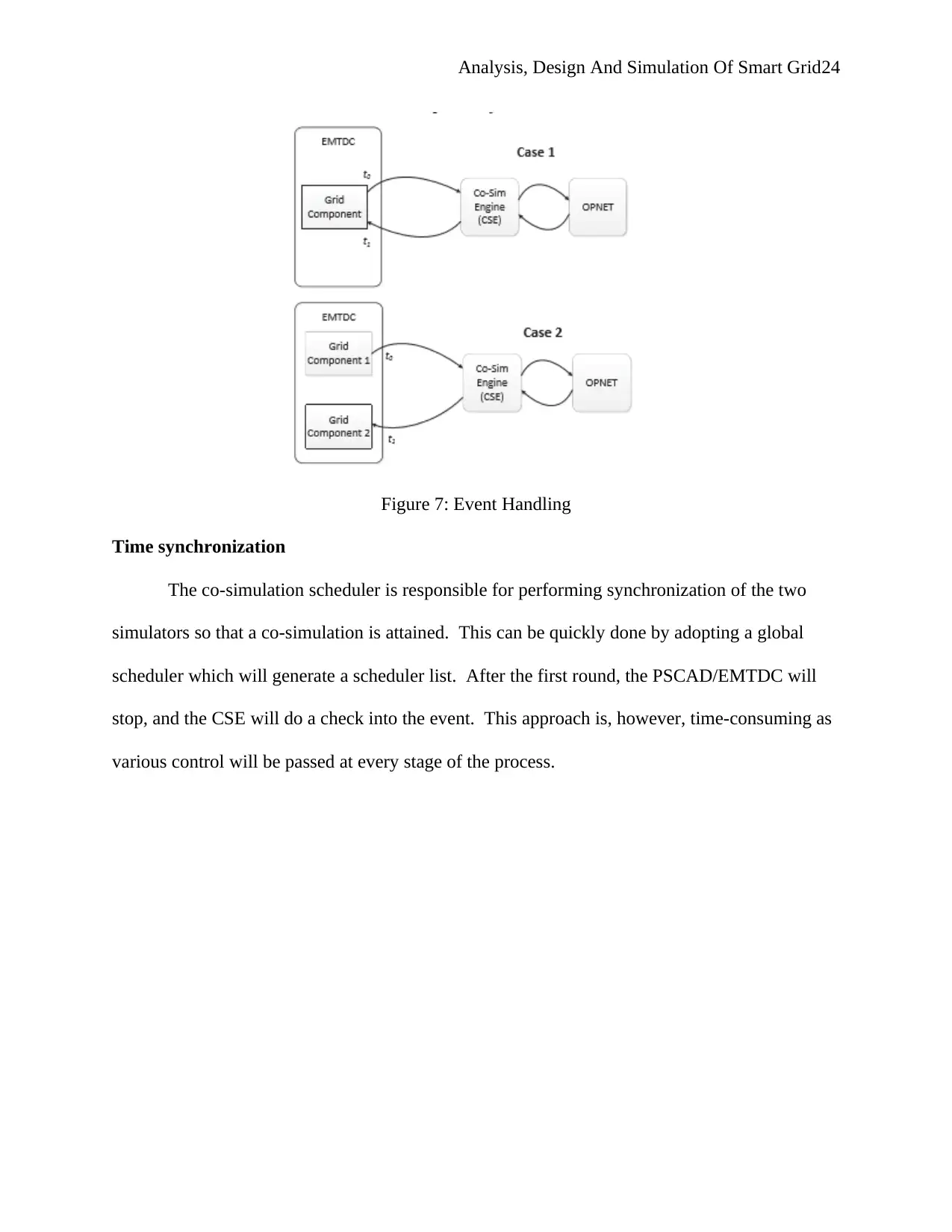
Analysis, Design And Simulation Of Smart Grid24
Figure 7: Event Handling
Time synchronization
The co-simulation scheduler is responsible for performing synchronization of the two
simulators so that a co-simulation is attained. This can be quickly done by adopting a global
scheduler which will generate a scheduler list. After the first round, the PSCAD/EMTDC will
stop, and the CSE will do a check into the event. This approach is, however, time-consuming as
various control will be passed at every stage of the process.
Figure 7: Event Handling
Time synchronization
The co-simulation scheduler is responsible for performing synchronization of the two
simulators so that a co-simulation is attained. This can be quickly done by adopting a global
scheduler which will generate a scheduler list. After the first round, the PSCAD/EMTDC will
stop, and the CSE will do a check into the event. This approach is, however, time-consuming as
various control will be passed at every stage of the process.

Analysis, Design And Simulation Of Smart Grid25
CHAPTER 3 METHODOLOGY
Research Methodology lays a systematic foundation for conducting research. The method
that would be undertaken for this research would be a literature review, where different
approaches of analysis, simulation, and design would be explored to identify which ones are the
most efficient to be used in conjunction. The data that would be required would include the
primary research that has been previously conducted by different authors, regardless of the
approach they followed. The data from these studies would be synthesized and assessed for
efficiency. Since this would be a literature review, the data will be analyzed by comparing the
data from the literature review along with other possible model predictions. The steps for this
methodology are illustrated below:
Figure 8 Steps for Methodology (Source: Self-created)
Description of Methodology
Generally, a literature review surveys the literature on a particular topic, synthesizes the
extracted information, critically analyses the information through the identification of knowledge
gaps by demonstrating limitations of viewpoints and theories, and presents the literature in an
organized manner (Lau et al., 2015). This research will look to display a familiarity with the
current knowledge about smart grids to establish clarity of work while also summarizing prior
research that has been conducted in this domain. This research would also look to summarize and
integrate what has been known about smart grids and what has been learned from the studies of
other authors.
Identifying Key
Terms
Locating
Literature
Evaluating
and Selecting
Literature
Organizing
Literature
Writing
Literature
Review
CHAPTER 3 METHODOLOGY
Research Methodology lays a systematic foundation for conducting research. The method
that would be undertaken for this research would be a literature review, where different
approaches of analysis, simulation, and design would be explored to identify which ones are the
most efficient to be used in conjunction. The data that would be required would include the
primary research that has been previously conducted by different authors, regardless of the
approach they followed. The data from these studies would be synthesized and assessed for
efficiency. Since this would be a literature review, the data will be analyzed by comparing the
data from the literature review along with other possible model predictions. The steps for this
methodology are illustrated below:
Figure 8 Steps for Methodology (Source: Self-created)
Description of Methodology
Generally, a literature review surveys the literature on a particular topic, synthesizes the
extracted information, critically analyses the information through the identification of knowledge
gaps by demonstrating limitations of viewpoints and theories, and presents the literature in an
organized manner (Lau et al., 2015). This research will look to display a familiarity with the
current knowledge about smart grids to establish clarity of work while also summarizing prior
research that has been conducted in this domain. This research would also look to summarize and
integrate what has been known about smart grids and what has been learned from the studies of
other authors.
Identifying Key
Terms
Locating
Literature
Evaluating
and Selecting
Literature
Organizing
Literature
Writing
Literature
Review
Paraphrase This Document
Need a fresh take? Get an instant paraphrase of this document with our AI Paraphraser
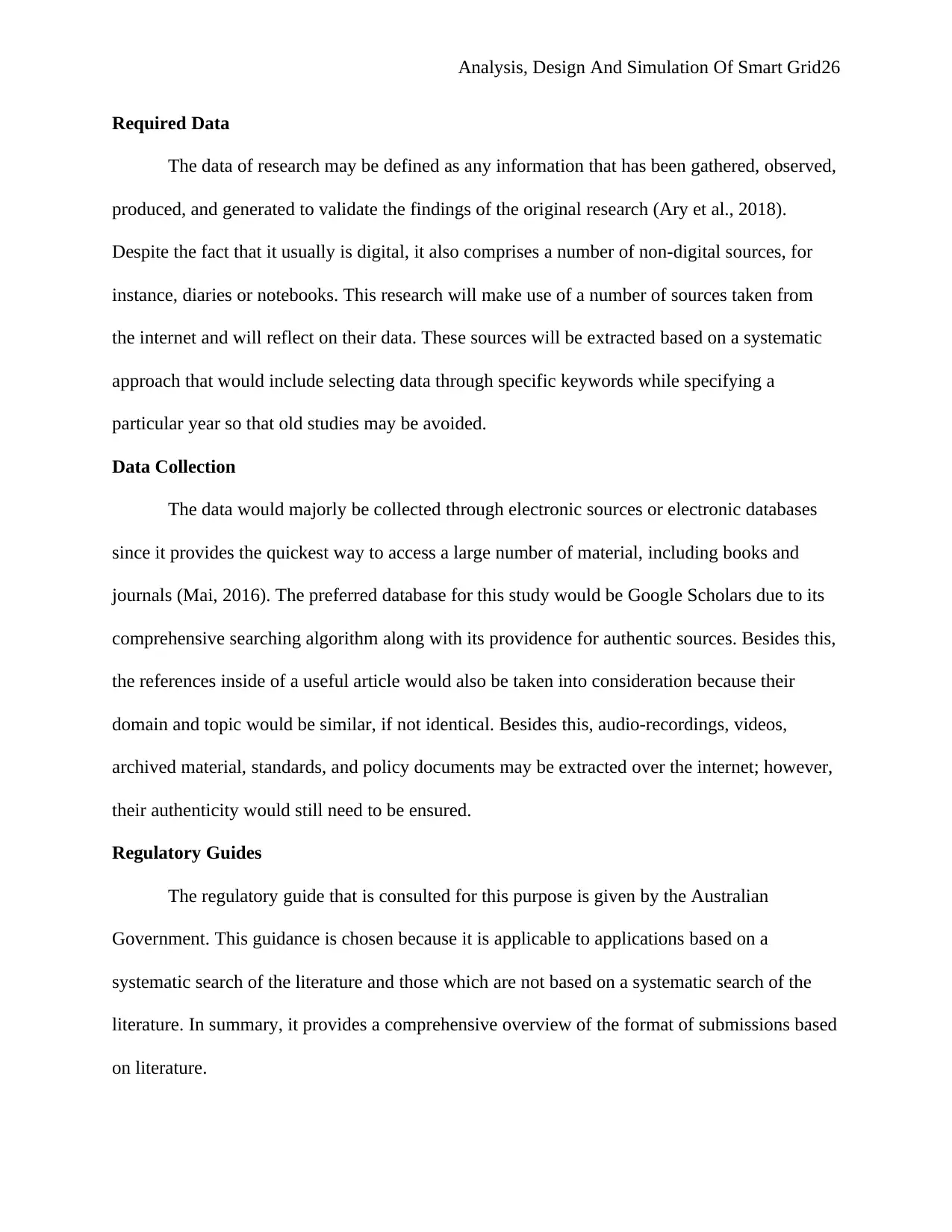
Analysis, Design And Simulation Of Smart Grid26
Required Data
The data of research may be defined as any information that has been gathered, observed,
produced, and generated to validate the findings of the original research (Ary et al., 2018).
Despite the fact that it usually is digital, it also comprises a number of non-digital sources, for
instance, diaries or notebooks. This research will make use of a number of sources taken from
the internet and will reflect on their data. These sources will be extracted based on a systematic
approach that would include selecting data through specific keywords while specifying a
particular year so that old studies may be avoided.
Data Collection
The data would majorly be collected through electronic sources or electronic databases
since it provides the quickest way to access a large number of material, including books and
journals (Mai, 2016). The preferred database for this study would be Google Scholars due to its
comprehensive searching algorithm along with its providence for authentic sources. Besides this,
the references inside of a useful article would also be taken into consideration because their
domain and topic would be similar, if not identical. Besides this, audio-recordings, videos,
archived material, standards, and policy documents may be extracted over the internet; however,
their authenticity would still need to be ensured.
Regulatory Guides
The regulatory guide that is consulted for this purpose is given by the Australian
Government. This guidance is chosen because it is applicable to applications based on a
systematic search of the literature and those which are not based on a systematic search of the
literature. In summary, it provides a comprehensive overview of the format of submissions based
on literature.
Required Data
The data of research may be defined as any information that has been gathered, observed,
produced, and generated to validate the findings of the original research (Ary et al., 2018).
Despite the fact that it usually is digital, it also comprises a number of non-digital sources, for
instance, diaries or notebooks. This research will make use of a number of sources taken from
the internet and will reflect on their data. These sources will be extracted based on a systematic
approach that would include selecting data through specific keywords while specifying a
particular year so that old studies may be avoided.
Data Collection
The data would majorly be collected through electronic sources or electronic databases
since it provides the quickest way to access a large number of material, including books and
journals (Mai, 2016). The preferred database for this study would be Google Scholars due to its
comprehensive searching algorithm along with its providence for authentic sources. Besides this,
the references inside of a useful article would also be taken into consideration because their
domain and topic would be similar, if not identical. Besides this, audio-recordings, videos,
archived material, standards, and policy documents may be extracted over the internet; however,
their authenticity would still need to be ensured.
Regulatory Guides
The regulatory guide that is consulted for this purpose is given by the Australian
Government. This guidance is chosen because it is applicable to applications based on a
systematic search of the literature and those which are not based on a systematic search of the
literature. In summary, it provides a comprehensive overview of the format of submissions based
on literature.

Analysis, Design And Simulation Of Smart Grid27
Data Analysis
The articles would be analyzed through comparison with current literature. However, to
thoroughly analyze these articles, they would be screened based on their relevancy, currency,
reliability, authority, provenance, persuasiveness, objectivity, accuracy, and value (Kodah,
2017). This implies that the articles would be analyzed based on their relevance to the topic, their
currency, whether the source is peer-reviewed or if the author belongs to a reputable institution
(Kodah, 2017). In addition, it would be identified if the arguments of the authors are supported
with evidence, whether their arguments are convincing, and whether the purpose has been
intelligibly stated (Kodah, 2017). It would also be seen if the article draws accurate conclusions
and references the sources accordingly. Their value should also be seen, especially ensuring that
the conclusions and opinions of the authors are convincing.
Expected Outcomes
The expected outcomes of this research are anticipated to be plenty. The research will
make the notion of smart grids easily understandable while also propose a methodology that the
smart grids system can implement to integrate their analysis, simulation, and design in a manner
that boasts significant levels of reliability, resilience, and efficiency. This paper would also be
expected to be published in a journal so that it is of help to all the researchers that would like to
continue this research in the future. Thus, this research would not only take the existing
knowledge of smart grids further, but it would also allow different authors to expand on this
further so that it is of benefit to the society as a whole.
Data Analysis
The articles would be analyzed through comparison with current literature. However, to
thoroughly analyze these articles, they would be screened based on their relevancy, currency,
reliability, authority, provenance, persuasiveness, objectivity, accuracy, and value (Kodah,
2017). This implies that the articles would be analyzed based on their relevance to the topic, their
currency, whether the source is peer-reviewed or if the author belongs to a reputable institution
(Kodah, 2017). In addition, it would be identified if the arguments of the authors are supported
with evidence, whether their arguments are convincing, and whether the purpose has been
intelligibly stated (Kodah, 2017). It would also be seen if the article draws accurate conclusions
and references the sources accordingly. Their value should also be seen, especially ensuring that
the conclusions and opinions of the authors are convincing.
Expected Outcomes
The expected outcomes of this research are anticipated to be plenty. The research will
make the notion of smart grids easily understandable while also propose a methodology that the
smart grids system can implement to integrate their analysis, simulation, and design in a manner
that boasts significant levels of reliability, resilience, and efficiency. This paper would also be
expected to be published in a journal so that it is of help to all the researchers that would like to
continue this research in the future. Thus, this research would not only take the existing
knowledge of smart grids further, but it would also allow different authors to expand on this
further so that it is of benefit to the society as a whole.
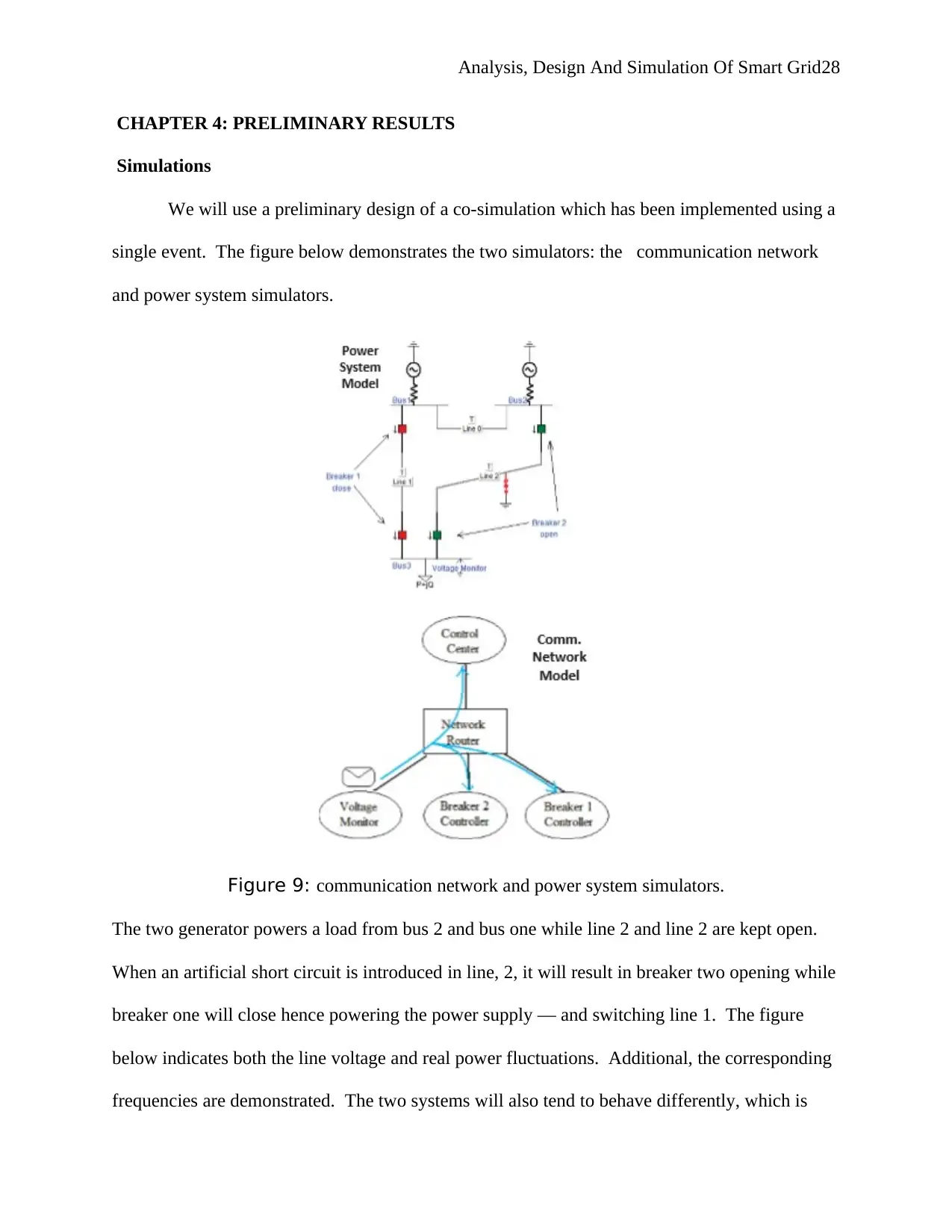
Analysis, Design And Simulation Of Smart Grid28
CHAPTER 4: PRELIMINARY RESULTS
Simulations
We will use a preliminary design of a co-simulation which has been implemented using a
single event. The figure below demonstrates the two simulators: the communication network
and power system simulators.
Figure 9: communication network and power system simulators.
The two generator powers a load from bus 2 and bus one while line 2 and line 2 are kept open.
When an artificial short circuit is introduced in line, 2, it will result in breaker two opening while
breaker one will close hence powering the power supply — and switching line 1. The figure
below indicates both the line voltage and real power fluctuations. Additional, the corresponding
frequencies are demonstrated. The two systems will also tend to behave differently, which is
CHAPTER 4: PRELIMINARY RESULTS
Simulations
We will use a preliminary design of a co-simulation which has been implemented using a
single event. The figure below demonstrates the two simulators: the communication network
and power system simulators.
Figure 9: communication network and power system simulators.
The two generator powers a load from bus 2 and bus one while line 2 and line 2 are kept open.
When an artificial short circuit is introduced in line, 2, it will result in breaker two opening while
breaker one will close hence powering the power supply — and switching line 1. The figure
below indicates both the line voltage and real power fluctuations. Additional, the corresponding
frequencies are demonstrated. The two systems will also tend to behave differently, which is
Secure Best Marks with AI Grader
Need help grading? Try our AI Grader for instant feedback on your assignments.

Analysis, Design And Simulation Of Smart Grid29
indicated in the figures as well. The measured latency from the OPNET simulator is 0.8333948
seconds. The demonstration validates that there is a possibility of successful communication or
connection between the OPNET \and PSCAD/EMTDC and OPNET. PSCAD/EMTDC.
Figure 10: Simulation Stands for Power Grid and Communication Network Respectively
indicated in the figures as well. The measured latency from the OPNET simulator is 0.8333948
seconds. The demonstration validates that there is a possibility of successful communication or
connection between the OPNET \and PSCAD/EMTDC and OPNET. PSCAD/EMTDC.
Figure 10: Simulation Stands for Power Grid and Communication Network Respectively
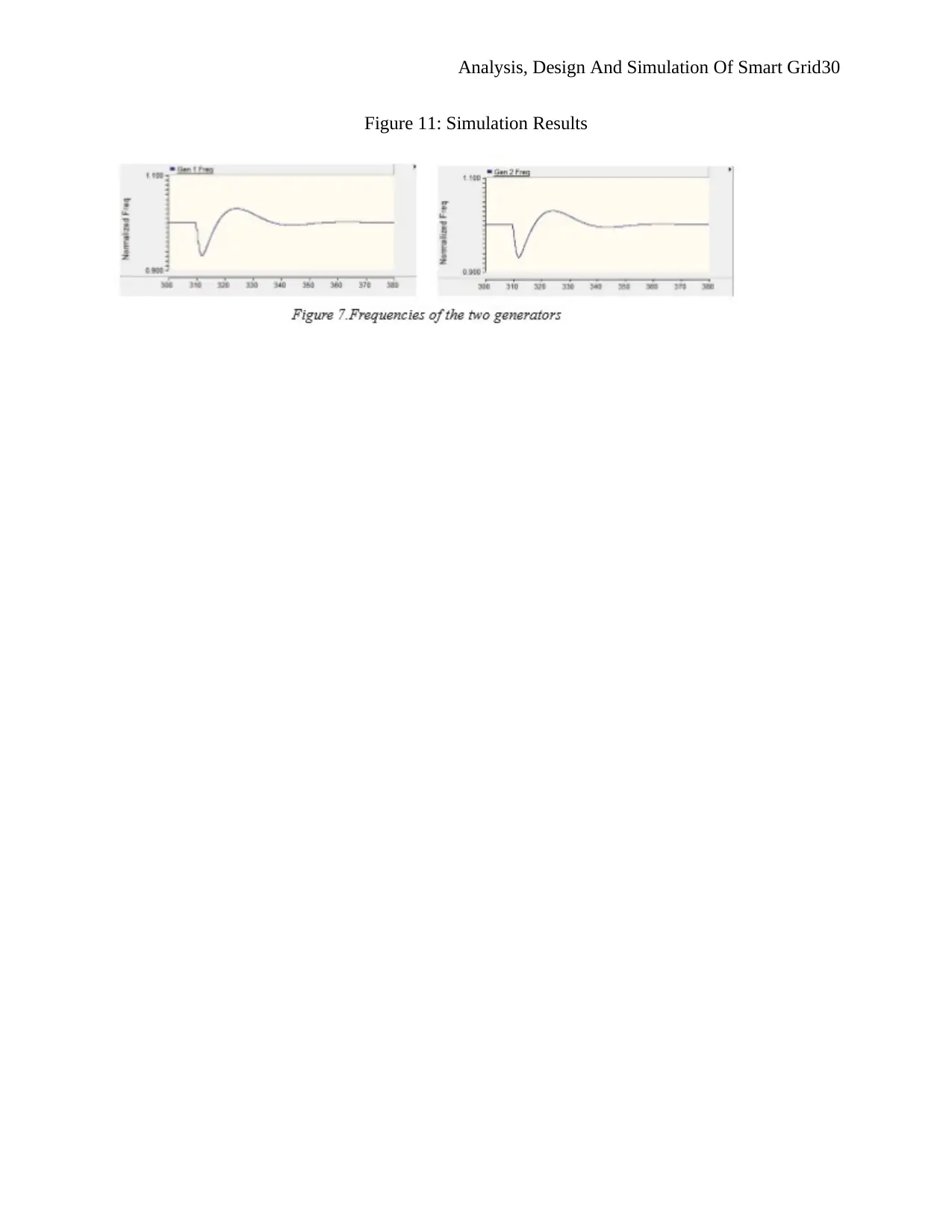
Analysis, Design And Simulation Of Smart Grid30
Figure 11: Simulation Results
Figure 11: Simulation Results
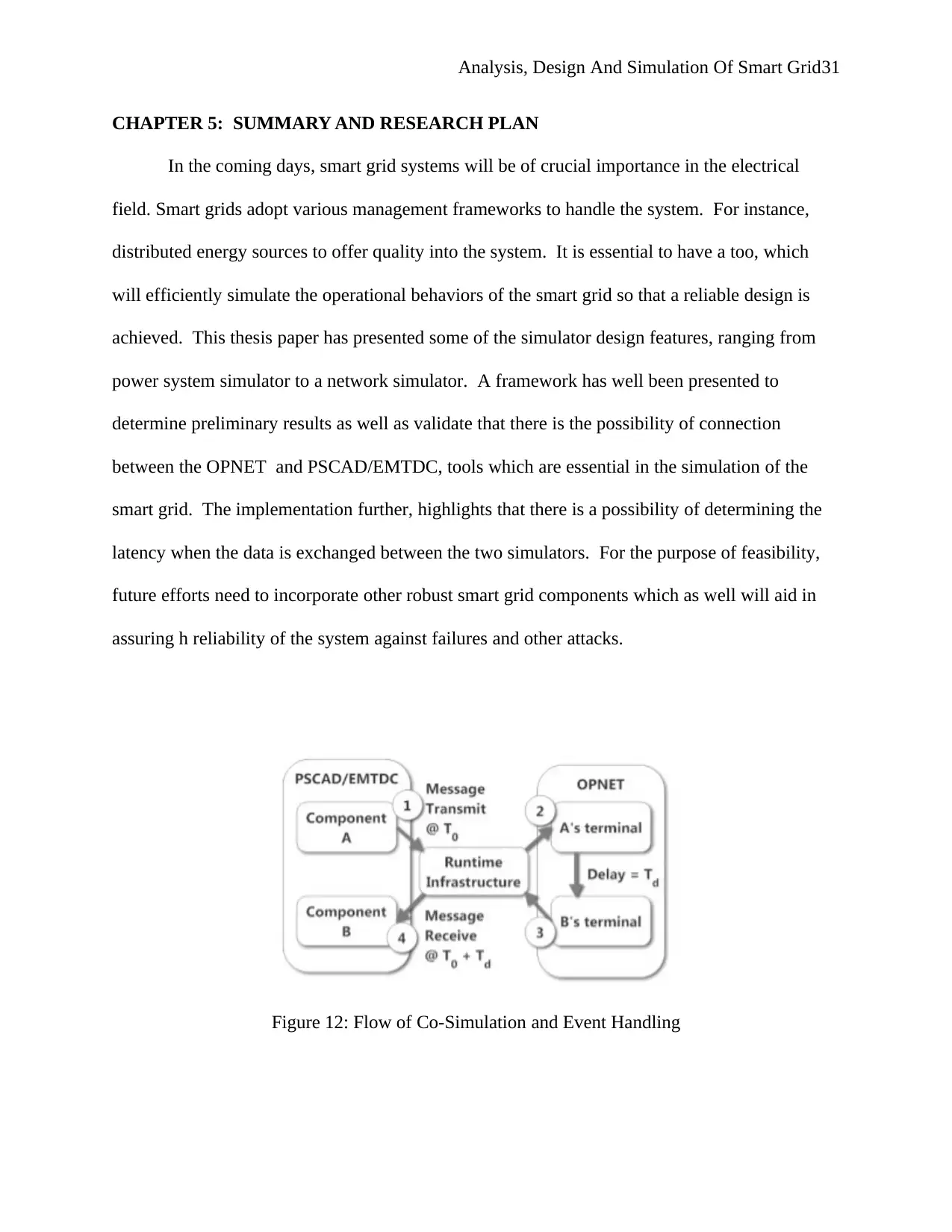
Analysis, Design And Simulation Of Smart Grid31
CHAPTER 5: SUMMARY AND RESEARCH PLAN
In the coming days, smart grid systems will be of crucial importance in the electrical
field. Smart grids adopt various management frameworks to handle the system. For instance,
distributed energy sources to offer quality into the system. It is essential to have a too, which
will efficiently simulate the operational behaviors of the smart grid so that a reliable design is
achieved. This thesis paper has presented some of the simulator design features, ranging from
power system simulator to a network simulator. A framework has well been presented to
determine preliminary results as well as validate that there is the possibility of connection
between the OPNET and PSCAD/EMTDC, tools which are essential in the simulation of the
smart grid. The implementation further, highlights that there is a possibility of determining the
latency when the data is exchanged between the two simulators. For the purpose of feasibility,
future efforts need to incorporate other robust smart grid components which as well will aid in
assuring h reliability of the system against failures and other attacks.
Figure 12: Flow of Co-Simulation and Event Handling
CHAPTER 5: SUMMARY AND RESEARCH PLAN
In the coming days, smart grid systems will be of crucial importance in the electrical
field. Smart grids adopt various management frameworks to handle the system. For instance,
distributed energy sources to offer quality into the system. It is essential to have a too, which
will efficiently simulate the operational behaviors of the smart grid so that a reliable design is
achieved. This thesis paper has presented some of the simulator design features, ranging from
power system simulator to a network simulator. A framework has well been presented to
determine preliminary results as well as validate that there is the possibility of connection
between the OPNET and PSCAD/EMTDC, tools which are essential in the simulation of the
smart grid. The implementation further, highlights that there is a possibility of determining the
latency when the data is exchanged between the two simulators. For the purpose of feasibility,
future efforts need to incorporate other robust smart grid components which as well will aid in
assuring h reliability of the system against failures and other attacks.
Figure 12: Flow of Co-Simulation and Event Handling
Paraphrase This Document
Need a fresh take? Get an instant paraphrase of this document with our AI Paraphraser

Analysis, Design And Simulation Of Smart Grid32
Smart Grid Reliability/Stability Analysis
The aspect of stability/ reliability of the smart grid is an extension of the conventional
approach of handling the power system analysis. This brings to our knowledge the aspect that
the smart grids can be easily represented through the conceptual models. From the literature
analysis and reviews, it is crystal clear that when renewable technologies are introduced,
unforeseen variances and patterns will be introduced into the power system: generation,
transmission, and eventual distribution. For instance, the outputs from both the solar and wind
technologies of harvesting energy remain highly unpredictable, which poses a significant
challenge to the operating frequency, voltage, phase, and the power level. Consequently,
upgrades in the smart grid system will necessitate for the conversion of the conventional stability
analysis into the new approaches using simulation tools and algorithms. Thus, a thorough
analysis in the as aspects of transient stability, cascading failure, contingency, and the estimation
needs to be conducted.
Table 1: Work Plan (Source: Self-created)
Smart Grid Reliability/Stability Analysis
The aspect of stability/ reliability of the smart grid is an extension of the conventional
approach of handling the power system analysis. This brings to our knowledge the aspect that
the smart grids can be easily represented through the conceptual models. From the literature
analysis and reviews, it is crystal clear that when renewable technologies are introduced,
unforeseen variances and patterns will be introduced into the power system: generation,
transmission, and eventual distribution. For instance, the outputs from both the solar and wind
technologies of harvesting energy remain highly unpredictable, which poses a significant
challenge to the operating frequency, voltage, phase, and the power level. Consequently,
upgrades in the smart grid system will necessitate for the conversion of the conventional stability
analysis into the new approaches using simulation tools and algorithms. Thus, a thorough
analysis in the as aspects of transient stability, cascading failure, contingency, and the estimation
needs to be conducted.
Table 1: Work Plan (Source: Self-created)
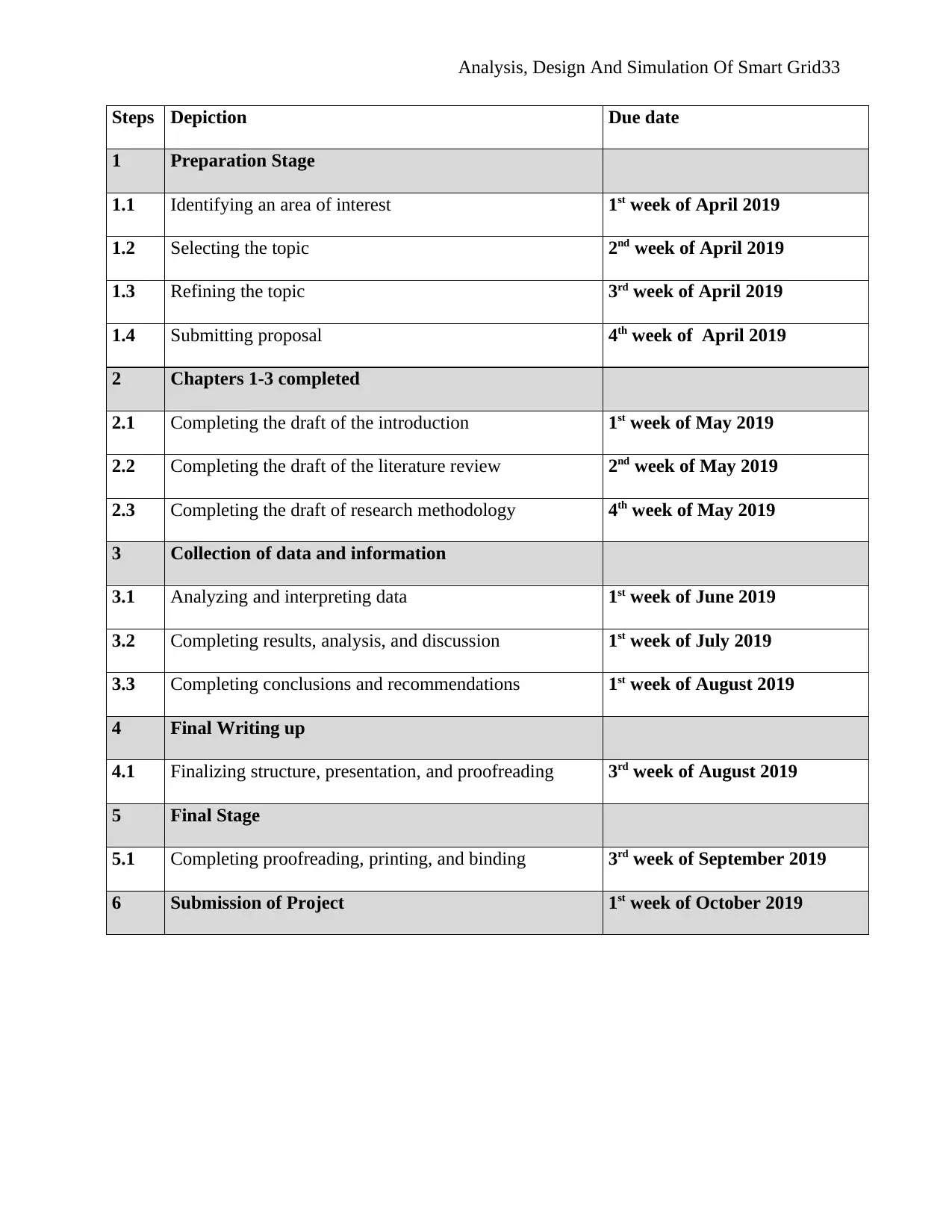
Analysis, Design And Simulation Of Smart Grid33
Steps Depiction Due date
1 Preparation Stage
1.1 Identifying an area of interest 1st week of April 2019
1.2 Selecting the topic 2nd week of April 2019
1.3 Refining the topic 3rd week of April 2019
1.4 Submitting proposal 4th week of April 2019
2 Chapters 1-3 completed
2.1 Completing the draft of the introduction 1st week of May 2019
2.2 Completing the draft of the literature review 2nd week of May 2019
2.3 Completing the draft of research methodology 4th week of May 2019
3 Collection of data and information
3.1 Analyzing and interpreting data 1st week of June 2019
3.2 Completing results, analysis, and discussion 1st week of July 2019
3.3 Completing conclusions and recommendations 1st week of August 2019
4 Final Writing up
4.1 Finalizing structure, presentation, and proofreading 3rd week of August 2019
5 Final Stage
5.1 Completing proofreading, printing, and binding 3rd week of September 2019
6 Submission of Project 1st week of October 2019
Steps Depiction Due date
1 Preparation Stage
1.1 Identifying an area of interest 1st week of April 2019
1.2 Selecting the topic 2nd week of April 2019
1.3 Refining the topic 3rd week of April 2019
1.4 Submitting proposal 4th week of April 2019
2 Chapters 1-3 completed
2.1 Completing the draft of the introduction 1st week of May 2019
2.2 Completing the draft of the literature review 2nd week of May 2019
2.3 Completing the draft of research methodology 4th week of May 2019
3 Collection of data and information
3.1 Analyzing and interpreting data 1st week of June 2019
3.2 Completing results, analysis, and discussion 1st week of July 2019
3.3 Completing conclusions and recommendations 1st week of August 2019
4 Final Writing up
4.1 Finalizing structure, presentation, and proofreading 3rd week of August 2019
5 Final Stage
5.1 Completing proofreading, printing, and binding 3rd week of September 2019
6 Submission of Project 1st week of October 2019

Analysis, Design And Simulation Of Smart Grid34
Time Schedule Months
Task Name
Duratio
n
(Days)
Start
Date
End
Date 1st
Apr
15th
Ap
r
1st
Ma
y
8th
Ma
y
22nd
Ma
y
1st
Ju
n
1st
Ju
l
1st
Au
g
15th
Au
g
16th
Sep
Task 1.1 &
1.2 14 Days
1st Apr 14th
Apr
Task 1.3 &
1.4 14 Days
15th
Apr
28th
Apr
Task 2.1 7 Days
1st May 7th
May
Task 2.2. 14 Days
8th
May
21st
May
Task 2.3 7 Days
22nd
May
28th
May
Task 3.1 28 Days
Time Schedule Months
Task Name
Duratio
n
(Days)
Start
Date
End
Date 1st
Apr
15th
Ap
r
1st
Ma
y
8th
Ma
y
22nd
Ma
y
1st
Ju
n
1st
Ju
l
1st
Au
g
15th
Au
g
16th
Sep
Task 1.1 &
1.2 14 Days
1st Apr 14th
Apr
Task 1.3 &
1.4 14 Days
15th
Apr
28th
Apr
Task 2.1 7 Days
1st May 7th
May
Task 2.2. 14 Days
8th
May
21st
May
Task 2.3 7 Days
22nd
May
28th
May
Task 3.1 28 Days
Secure Best Marks with AI Grader
Need help grading? Try our AI Grader for instant feedback on your assignments.

Analysis, Design And Simulation Of Smart Grid35
1st Jun 28th
Jun
Task 3.2 28 Days
1st Jul 28th
Jul
Task 3.3 14 Days
1st Aug 14th
Aug
Task 4.1 28 Days
15th
Aug
15th
Sep
Task 5.1 14 Days
16th
Sep
1st
Oct
Table 2: Gantt chart (Source: Self-created)
1st Jun 28th
Jun
Task 3.2 28 Days
1st Jul 28th
Jul
Task 3.3 14 Days
1st Aug 14th
Aug
Task 4.1 28 Days
15th
Aug
15th
Sep
Task 5.1 14 Days
16th
Sep
1st
Oct
Table 2: Gantt chart (Source: Self-created)

Analysis, Design And Simulation Of Smart Grid36
References
Albasrawi, M. N., Jarus, N., Joshi, K. A., and Sarvestani, S. S. (2014) ‘Analysis of reliability and
resilience for smart grids’, In 2014 IEEE 38th Annual Computer Software and
Applications Conference (pp. 529-534). United States: IEEE.
Amin, S.M. and Wollenberg, B.F., 2015. Toward a smart grid: power delivery for the 21st
century. IEEE power and energy magazine, 3(5), pp.34-41.
Anderson, K., Du, J., Narayan, A. and El Gamal, A., 2014. GridSpice: A distributed simulation
platform for the smart grid. IEEE Transactions on Industrial Informatics, 10(4), pp.2354-
2363.
Ary, D., Jacobs, L. C., Irvine, C. K. S. and Walker, D. (2018) Introduction to research in
education. United States: Cengage Learning
Australian Government (2014) Dossier requirements for literature based submissions. [Online]
Available from <https://www.tga.gov.au/dossier-requirements-literature-based-
submissions> [Accessed: 24th April 2019]
Cintuglu, M. H., Mohammed, O. A., Akkaya, K. and Uluagac, A. S. (2017) ‘A survey on smart
grid cyber-physical system testbeds’, IEEE Communications Surveys and
Tutorials, 19(1), 446-464
Efthymiou, C. and Kalogridis, G., 2010, October. Smart grid privacy via anonymization of smart
metering data. In 2010 First IEEE International Conference on Smart Grid
Communications (pp. 238-243). IEEE.
Fang, X., Misra, S., Xue, G. and Yang, D., 2011. Smart grid—The new and improved power
grid: A survey. IEEE communications surveys & tutorials, 14(4), pp.944-980.
References
Albasrawi, M. N., Jarus, N., Joshi, K. A., and Sarvestani, S. S. (2014) ‘Analysis of reliability and
resilience for smart grids’, In 2014 IEEE 38th Annual Computer Software and
Applications Conference (pp. 529-534). United States: IEEE.
Amin, S.M. and Wollenberg, B.F., 2015. Toward a smart grid: power delivery for the 21st
century. IEEE power and energy magazine, 3(5), pp.34-41.
Anderson, K., Du, J., Narayan, A. and El Gamal, A., 2014. GridSpice: A distributed simulation
platform for the smart grid. IEEE Transactions on Industrial Informatics, 10(4), pp.2354-
2363.
Ary, D., Jacobs, L. C., Irvine, C. K. S. and Walker, D. (2018) Introduction to research in
education. United States: Cengage Learning
Australian Government (2014) Dossier requirements for literature based submissions. [Online]
Available from <https://www.tga.gov.au/dossier-requirements-literature-based-
submissions> [Accessed: 24th April 2019]
Cintuglu, M. H., Mohammed, O. A., Akkaya, K. and Uluagac, A. S. (2017) ‘A survey on smart
grid cyber-physical system testbeds’, IEEE Communications Surveys and
Tutorials, 19(1), 446-464
Efthymiou, C. and Kalogridis, G., 2010, October. Smart grid privacy via anonymization of smart
metering data. In 2010 First IEEE International Conference on Smart Grid
Communications (pp. 238-243). IEEE.
Fang, X., Misra, S., Xue, G. and Yang, D., 2011. Smart grid—The new and improved power
grid: A survey. IEEE communications surveys & tutorials, 14(4), pp.944-980.
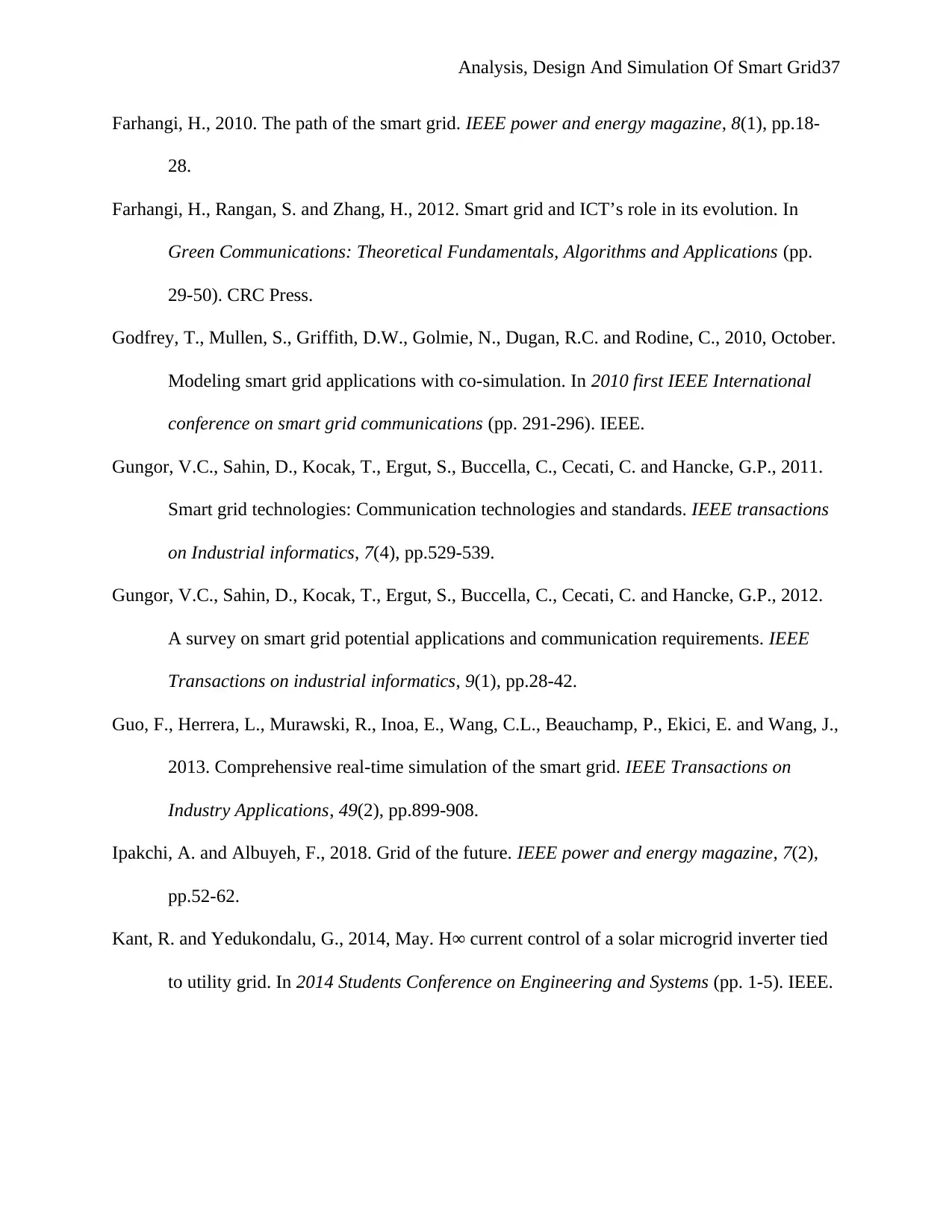
Analysis, Design And Simulation Of Smart Grid37
Farhangi, H., 2010. The path of the smart grid. IEEE power and energy magazine, 8(1), pp.18-
28.
Farhangi, H., Rangan, S. and Zhang, H., 2012. Smart grid and ICT’s role in its evolution. In
Green Communications: Theoretical Fundamentals, Algorithms and Applications (pp.
29-50). CRC Press.
Godfrey, T., Mullen, S., Griffith, D.W., Golmie, N., Dugan, R.C. and Rodine, C., 2010, October.
Modeling smart grid applications with co-simulation. In 2010 first IEEE International
conference on smart grid communications (pp. 291-296). IEEE.
Gungor, V.C., Sahin, D., Kocak, T., Ergut, S., Buccella, C., Cecati, C. and Hancke, G.P., 2011.
Smart grid technologies: Communication technologies and standards. IEEE transactions
on Industrial informatics, 7(4), pp.529-539.
Gungor, V.C., Sahin, D., Kocak, T., Ergut, S., Buccella, C., Cecati, C. and Hancke, G.P., 2012.
A survey on smart grid potential applications and communication requirements. IEEE
Transactions on industrial informatics, 9(1), pp.28-42.
Guo, F., Herrera, L., Murawski, R., Inoa, E., Wang, C.L., Beauchamp, P., Ekici, E. and Wang, J.,
2013. Comprehensive real-time simulation of the smart grid. IEEE Transactions on
Industry Applications, 49(2), pp.899-908.
Ipakchi, A. and Albuyeh, F., 2018. Grid of the future. IEEE power and energy magazine, 7(2),
pp.52-62.
Kant, R. and Yedukondalu, G., 2014, May. H∞ current control of a solar microgrid inverter tied
to utility grid. In 2014 Students Conference on Engineering and Systems (pp. 1-5). IEEE.
Farhangi, H., 2010. The path of the smart grid. IEEE power and energy magazine, 8(1), pp.18-
28.
Farhangi, H., Rangan, S. and Zhang, H., 2012. Smart grid and ICT’s role in its evolution. In
Green Communications: Theoretical Fundamentals, Algorithms and Applications (pp.
29-50). CRC Press.
Godfrey, T., Mullen, S., Griffith, D.W., Golmie, N., Dugan, R.C. and Rodine, C., 2010, October.
Modeling smart grid applications with co-simulation. In 2010 first IEEE International
conference on smart grid communications (pp. 291-296). IEEE.
Gungor, V.C., Sahin, D., Kocak, T., Ergut, S., Buccella, C., Cecati, C. and Hancke, G.P., 2011.
Smart grid technologies: Communication technologies and standards. IEEE transactions
on Industrial informatics, 7(4), pp.529-539.
Gungor, V.C., Sahin, D., Kocak, T., Ergut, S., Buccella, C., Cecati, C. and Hancke, G.P., 2012.
A survey on smart grid potential applications and communication requirements. IEEE
Transactions on industrial informatics, 9(1), pp.28-42.
Guo, F., Herrera, L., Murawski, R., Inoa, E., Wang, C.L., Beauchamp, P., Ekici, E. and Wang, J.,
2013. Comprehensive real-time simulation of the smart grid. IEEE Transactions on
Industry Applications, 49(2), pp.899-908.
Ipakchi, A. and Albuyeh, F., 2018. Grid of the future. IEEE power and energy magazine, 7(2),
pp.52-62.
Kant, R. and Yedukondalu, G., 2014, May. H∞ current control of a solar microgrid inverter tied
to utility grid. In 2014 Students Conference on Engineering and Systems (pp. 1-5). IEEE.
Paraphrase This Document
Need a fresh take? Get an instant paraphrase of this document with our AI Paraphraser

Analysis, Design And Simulation Of Smart Grid38
Karnouskos, S. and De Holanda, T.N., 2009, November. Simulation of a smart grid city with
software agents. In 2009 Third UKSim European Symposium on Computer Modeling and
Simulation (pp. 424-429). IEEE.
Ketter, W., Collins, J. and Reddy, P., 2013. Power TAC: A competitive economic simulation of
the smart grid. Energy Economics, 39, pp.262-270.
Kodah, M. K. (2017) ‘Literature Review as an Indispensable Component of Academic Research
in the Humanities’, Perspectives on Conducting and Reporting Research in the
Humanities.
Kong, K.M., 2013. Development of demand side management system: diagnostic tool and load
recognition (Doctoral dissertation, UTAR).
Lau, R., Stevenson, F., Ong, B. N., Dziedzic, K., Treweek, S., Eldridge, S. and Peacock, R.
(2015) ‘Achieving change in primary care—causes of the evidence to practice gap:
systematic reviews of reviews’, Implementation Science, 11(1), 40
Li, W. and Zhang, X. (2014) ‘Simulation of the smart grid communications: Challenges,
techniques, and future trends’, Computers and Electrical Engineering, 40(1), 270-288
Liberatore, V. and Al-Hammouri, A., 2011, May. Smart grid communication and co-simulation.
In IEEE 2011 EnergyTech (pp. 1-5). IEEE.
Lin, H., Sambamoorthy, S., Shukla, S., Thorp, J. and Mili, L., 2011, January. Power system and
communication network co-simulation for smart grid applications. In ISGT 2011 (pp. 1-
6). IEEE.
Lobaccaro, G., Carlucci, S. and Löfström, E. (2016) ‘A review of systems and technologies for
smart homes and smart grids’, Energies, 9(5), 348
Karnouskos, S. and De Holanda, T.N., 2009, November. Simulation of a smart grid city with
software agents. In 2009 Third UKSim European Symposium on Computer Modeling and
Simulation (pp. 424-429). IEEE.
Ketter, W., Collins, J. and Reddy, P., 2013. Power TAC: A competitive economic simulation of
the smart grid. Energy Economics, 39, pp.262-270.
Kodah, M. K. (2017) ‘Literature Review as an Indispensable Component of Academic Research
in the Humanities’, Perspectives on Conducting and Reporting Research in the
Humanities.
Kong, K.M., 2013. Development of demand side management system: diagnostic tool and load
recognition (Doctoral dissertation, UTAR).
Lau, R., Stevenson, F., Ong, B. N., Dziedzic, K., Treweek, S., Eldridge, S. and Peacock, R.
(2015) ‘Achieving change in primary care—causes of the evidence to practice gap:
systematic reviews of reviews’, Implementation Science, 11(1), 40
Li, W. and Zhang, X. (2014) ‘Simulation of the smart grid communications: Challenges,
techniques, and future trends’, Computers and Electrical Engineering, 40(1), 270-288
Liberatore, V. and Al-Hammouri, A., 2011, May. Smart grid communication and co-simulation.
In IEEE 2011 EnergyTech (pp. 1-5). IEEE.
Lin, H., Sambamoorthy, S., Shukla, S., Thorp, J. and Mili, L., 2011, January. Power system and
communication network co-simulation for smart grid applications. In ISGT 2011 (pp. 1-
6). IEEE.
Lobaccaro, G., Carlucci, S. and Löfström, E. (2016) ‘A review of systems and technologies for
smart homes and smart grids’, Energies, 9(5), 348

Analysis, Design And Simulation Of Smart Grid39
Mai, J. E. (2016) Looking for information: A survey of research on information seeking, needs,
and behaviour. United Kingdom: Emerald Group Publishing
Marashi, K. and Sarvestani, S. S. (2014) ‘Towards comprehensive modeling of reliability for
smart grids: Requirements and challenges’, In, 2014 IEEE 15th International Symposium
on High-Assurance Systems Engineering (pp. 105-112). United States: IEEE
McDaniel, P. and McLaughlin, S., 2009. Security and privacy challenges in the smart grid. IEEE
Security & Privacy, 7(3), pp.75-77.
Mekkaoui, A., Laouer, M. and Mimoun, Y. (2017) ‘Modeling and simulation for smart grid
integration of solar/wind energy’, Leonardo Journal of Sciences, 30, 31-46
Mets, K., Ojea, J.A. and Develder, C., 2014. Combining power and communication network
simulation for cost-effective smart grid analysis. IEEE Communications Surveys &
Tutorials, 16(3), pp.1771-1796.
Mets, K., Verschueren, T., Develder, C., Vandoorn, T.L. and Vandevelde, L., 2011, June.
Integrated simulation of power and communication networks for smart grid applications.
In 2011 IEEE 16th International Workshop on Computer Aided Modeling and Design of
Communication Links and Networks (CAMAD) (pp. 61-65). IEEE.
Momoh, J.A., 2012. Smart grid: fundamentals of design and analysis (Vol. 63). John Wiley &
Sons.
Moslehi, K. and Kumar, R., 2010. A reliability perspective of the smart grid. IEEE Trans. Smart
Grid, 1(1), pp.57-64.
Oliveira, P., Pinto, T., Morais, H. and Vale, Z., 2012, July. MASGriP—a multi-agent smart grid
simulation platform. In 2012 IEEE Power and Energy Society General Meeting (pp. 1-8).
IEEE.
Mai, J. E. (2016) Looking for information: A survey of research on information seeking, needs,
and behaviour. United Kingdom: Emerald Group Publishing
Marashi, K. and Sarvestani, S. S. (2014) ‘Towards comprehensive modeling of reliability for
smart grids: Requirements and challenges’, In, 2014 IEEE 15th International Symposium
on High-Assurance Systems Engineering (pp. 105-112). United States: IEEE
McDaniel, P. and McLaughlin, S., 2009. Security and privacy challenges in the smart grid. IEEE
Security & Privacy, 7(3), pp.75-77.
Mekkaoui, A., Laouer, M. and Mimoun, Y. (2017) ‘Modeling and simulation for smart grid
integration of solar/wind energy’, Leonardo Journal of Sciences, 30, 31-46
Mets, K., Ojea, J.A. and Develder, C., 2014. Combining power and communication network
simulation for cost-effective smart grid analysis. IEEE Communications Surveys &
Tutorials, 16(3), pp.1771-1796.
Mets, K., Verschueren, T., Develder, C., Vandoorn, T.L. and Vandevelde, L., 2011, June.
Integrated simulation of power and communication networks for smart grid applications.
In 2011 IEEE 16th International Workshop on Computer Aided Modeling and Design of
Communication Links and Networks (CAMAD) (pp. 61-65). IEEE.
Momoh, J.A., 2012. Smart grid: fundamentals of design and analysis (Vol. 63). John Wiley &
Sons.
Moslehi, K. and Kumar, R., 2010. A reliability perspective of the smart grid. IEEE Trans. Smart
Grid, 1(1), pp.57-64.
Oliveira, P., Pinto, T., Morais, H. and Vale, Z., 2012, July. MASGriP—a multi-agent smart grid
simulation platform. In 2012 IEEE Power and Energy Society General Meeting (pp. 1-8).
IEEE.

Analysis, Design And Simulation Of Smart Grid40
Palensky, P. and Dietrich, D., 2011. Demand side management: Demand response, intelligent
energy systems, and smart loads. IEEE transactions on industrial informatics, 7(3),
pp.381-388.
Pérez, J., Díaz, J. and González. E. (2013) Designing and Simulating Smart Grids [Online]
Available from <https://ercim-news.ercim.eu/en92/special/designing-and-simulating-
smart-grids> [Accessed: 24th April 2019]
Pinson, P. and Madsen, H. (2014) ‘Benefits and challenges of electrical demand response: A
critical review’, Renewable and Sustainable Energy Reviews, 39, 686-699
Saad, W., Han, Z., Poor, H.V. and Başar, T., 2012. Game theoretic methods for the smart grid.
arXiv preprint arXiv:1202.0452.
Samadi, P., Mohsenian-Rad, A.H., Schober, R., Wong, V.W. and Jatskevich, J., 2010, October.
Optimal real-time pricing algorithm based on utility maximization for smart grid. In 2010
First IEEE International Conference on Smart Grid Communications (pp. 415-420).
IEEE.
Samadi, P., Rad, A.H.M., Schober, R. and Wong, V.W., 2012. Advanced Demand Side
Management for the Future Smart Grid Using Mechanism Design. IEEE Trans. Smart
Grid, 3(3), pp.1170-1180.
Shaukat, N., Ali, S. M., Mehmood, C. A., Khan, B., Jawad, M., Farid, U. and Majid, M. (2018)
‘A survey on consumers’ empowerment, communication technologies, and renewable
generation penetration within Smart Grid’, Renewable and Sustainable Energy
Reviews, 81, 1453-1475
Siano, P. (2014) ‘Demand response and smart grids—A survey’, Renewable and sustainable
energy reviews, 30, 461-478
Palensky, P. and Dietrich, D., 2011. Demand side management: Demand response, intelligent
energy systems, and smart loads. IEEE transactions on industrial informatics, 7(3),
pp.381-388.
Pérez, J., Díaz, J. and González. E. (2013) Designing and Simulating Smart Grids [Online]
Available from <https://ercim-news.ercim.eu/en92/special/designing-and-simulating-
smart-grids> [Accessed: 24th April 2019]
Pinson, P. and Madsen, H. (2014) ‘Benefits and challenges of electrical demand response: A
critical review’, Renewable and Sustainable Energy Reviews, 39, 686-699
Saad, W., Han, Z., Poor, H.V. and Başar, T., 2012. Game theoretic methods for the smart grid.
arXiv preprint arXiv:1202.0452.
Samadi, P., Mohsenian-Rad, A.H., Schober, R., Wong, V.W. and Jatskevich, J., 2010, October.
Optimal real-time pricing algorithm based on utility maximization for smart grid. In 2010
First IEEE International Conference on Smart Grid Communications (pp. 415-420).
IEEE.
Samadi, P., Rad, A.H.M., Schober, R. and Wong, V.W., 2012. Advanced Demand Side
Management for the Future Smart Grid Using Mechanism Design. IEEE Trans. Smart
Grid, 3(3), pp.1170-1180.
Shaukat, N., Ali, S. M., Mehmood, C. A., Khan, B., Jawad, M., Farid, U. and Majid, M. (2018)
‘A survey on consumers’ empowerment, communication technologies, and renewable
generation penetration within Smart Grid’, Renewable and Sustainable Energy
Reviews, 81, 1453-1475
Siano, P. (2014) ‘Demand response and smart grids—A survey’, Renewable and sustainable
energy reviews, 30, 461-478
Secure Best Marks with AI Grader
Need help grading? Try our AI Grader for instant feedback on your assignments.

Analysis, Design And Simulation Of Smart Grid41
Su, C.L., Lu, C.N., Zheng, K.E., Teng, J.H., Leou, R.C. and Huang, K.F., 2014, October.
Analysis of PEV charging impact on distribution transformer aging for charging station
transformer design. In 2014 IEEE Industry Application Society Annual Meeting (pp. 1-8).
IEEE.
Wang, B., Sechilariu, M. and Locment, F., 2012. Intelligent DC microgrid with smart grid
communications: Control strategy consideration and design. IEEE transactions on smart
grid, 3(4), pp.2148-2156.
Wang, J. and Costa, L.M., 2016, November. On the design of standard application function
blocks for microgrid automation. In 2016 IEEE Innovative Smart Grid Technologies-
Asia (ISGT-Asia) (pp. 1157-1164). IEEE.
Yan, Y., Qian, Y., Sharif, H. and Tipper, D., 2012. A survey on smart grid communication
infrastructures: Motivations, requirements and challenges. IEEE communications surveys
& tutorials, 15(1), pp.5-20.
Yu, X. and Xue, Y. (2016) ‘Smart grids: A cyber–physical systems perspective’, Proceedings of
the IEEE, 104(5), 1058-1070
Su, C.L., Lu, C.N., Zheng, K.E., Teng, J.H., Leou, R.C. and Huang, K.F., 2014, October.
Analysis of PEV charging impact on distribution transformer aging for charging station
transformer design. In 2014 IEEE Industry Application Society Annual Meeting (pp. 1-8).
IEEE.
Wang, B., Sechilariu, M. and Locment, F., 2012. Intelligent DC microgrid with smart grid
communications: Control strategy consideration and design. IEEE transactions on smart
grid, 3(4), pp.2148-2156.
Wang, J. and Costa, L.M., 2016, November. On the design of standard application function
blocks for microgrid automation. In 2016 IEEE Innovative Smart Grid Technologies-
Asia (ISGT-Asia) (pp. 1157-1164). IEEE.
Yan, Y., Qian, Y., Sharif, H. and Tipper, D., 2012. A survey on smart grid communication
infrastructures: Motivations, requirements and challenges. IEEE communications surveys
& tutorials, 15(1), pp.5-20.
Yu, X. and Xue, Y. (2016) ‘Smart grids: A cyber–physical systems perspective’, Proceedings of
the IEEE, 104(5), 1058-1070
1 out of 41
Related Documents
Your All-in-One AI-Powered Toolkit for Academic Success.
+13062052269
info@desklib.com
Available 24*7 on WhatsApp / Email
![[object Object]](/_next/static/media/star-bottom.7253800d.svg)
Unlock your academic potential
© 2024 | Zucol Services PVT LTD | All rights reserved.




